May 1, 2015
Air Date: May 1, 2015
FULL SHOW
SEGMENTS
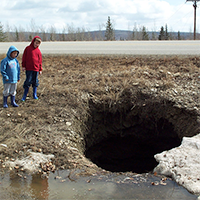
Siberia’s Mysterious Craters
View the page for this story
Dozens of mysterious craters have recently appeared in northwestern Siberia, with rock and soil blasted hundreds of yards away. But with no evidence of an explosion, scientists believe that warming temperatures might be to blame. University of Alaska geophysicist Vladimir Romanovsky explains to host Steve Curwood that as the permafrost melts, it releases warming greenhouse gases, which then promote further warming. (06:00)
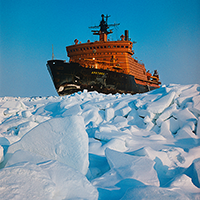
Leading at the Top of the World
View the page for this story
The US recently took the reins of the Arctic Council, a group of 8 arctic nations and observers, which helps craft environmental and social policy for the region. As the Arctic warms, it opens the ocean there for navigation and oil and gas exploration. Mead Treadwell, the former Lt. Governor of Alaska tells host Steve Curwood there are many areas of co-operation among the arctic nations, but also issues that create tension and rivalry. (08:50)
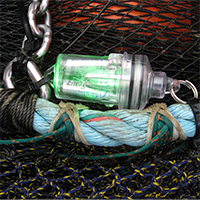
Illuminated Fishing Nets Prevent Bycatch
/ Emmett FitzGeraldView the page for this story
Bycatch is an economic and environmental problem for commercial fishing. Large trawlers often scoop up sea-life other than the species they're targeting, and if there’s too much bycatch fishermen sometimes have to dump their catch. But Bob Hannah of the Oregon Department of Fish and Wildlife may have found a simple, affordable solution. He tells Living on Earth's Emmett FitzGerald how local shrimp fishermen are eliminating bycatch of an important smelt species by lighting up their nets with LEDs. (07:00)
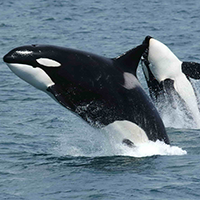
Calling Over Boat Noise Is Making Orcas Hungry
/ Ashley AhearnView the page for this story
The Pacific Northwest is a nautical hub for ships and naval training, and the resulting engine noise is drowning out local marine life. Endangered orcas struggling to be heard increase the volume of their calls, and as EarthFix’s Ashley Ahearn reports, this extra effort requires them to eat more, and could stress the whales. (02:55)
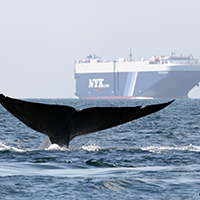
Protecting Blue Whales and Blue Skies
/ John DuffView the page for this story
The Santa Barbara Channel off the coast of California teems with marine life and container ships, both competing for space. Whale fatalities from ship-strikes and polluting emissions from ships are both high. Santa Barbara County Air Pollution Control’s Mary Byrd explains to Living on Earth’s John Duff that local officials and ship interests are co-operating there to improve air quality and protect endangered whales. (06:50)

Beyond the Headlines
/ Peter DykstraView the page for this story
In this week’s trip beyond the headlines, Peter Dykstra tells host Steve Curwood about climate deniers’ chilly response to the Pope’s climate summit, the murder of environmental activists around the world, and the gap between experiences provided from living in nature and those from our human-made, technological world. (04:20)

The GOP's Lonely Climate Warrior
View the page for this story
Bob Inglis, a six-term Republican Congressman from South Carolina, knew that addressing climate change wasn't going to be popular within his party, and his strong stance on global warming helped a Tea Party challenger beat him in a primary in 2010. But Representative Inglis’s efforts have won him the JFK Library Foundation’s Profiles in Courage Award. Bob Inglis discusses the award with host Steve Curwood and explains why the climate became his top priority and why more conservatives need to get on board. (07:55)
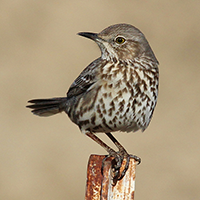
BirdNote: Vocabularies of Birdsong
/ Mary McCannView the page for this story
Around the world at any given time, a bird is singing, and as BirdNote’s Mary McCann reports, though their songs all differ in type and length, they mostly have the same intention, laying claim to territory and mates. (02:00)
Show Credits and Funders
Show Transcript
HOST: Steve Curwood
GUESTS: Vladimir Romanovsky, Mead Treadwell, Mary Byrd, Bob Hannah, Bob Inglis
REPORTERS: Ashley Ahearn, Mary McCann, Peter Dykstra
[THEME]
CURWOOD: From Public Radio International, this is Living on Earth.
[THEME]
CURWOOD: I'm Steve Curwood. A conservative Republican wins an award for courage from a foundation named after a liberal Democrat, for demanding action on global warming, putting himself at odds with his party.
INGLIS: It’s lonely at times, of course when you look around after saying something and you realize hey, there’s not many people saying “Amen." You sort of hear crickets after you’ve said something, but while it can be lonely, it’s also very exciting.
CURWOOD: Why former Congressman Bob Inglis is taking this stand. Also, bright lights as a solution to bycatch problems for shrimpers.
HANNAH: We moved the lights from one net to another, and every time we moved the lights to that side the vast majority of bycatch didn't show up in the net. If you have a lot of bycatch you might have to dump the whole tow, 3 or 4 or 5,000 pounds of shrimp, and at 50 cents a pound that covers the lights.
CURWOOD: We’ll have that and more this week on Living on Earth. Stick around.
[NEWSBREAK MUSIC: Boards Of Canada “Zoetrope” from “In A Beautiful Place Out In The Country” (Warp Records 2000)]
ANNOUNCER: Support for Living on Earth comes from United Technologies – innovating to make the world a better, more sustainable place to live.
[THEME]
Siberia’s Mysterious Craters
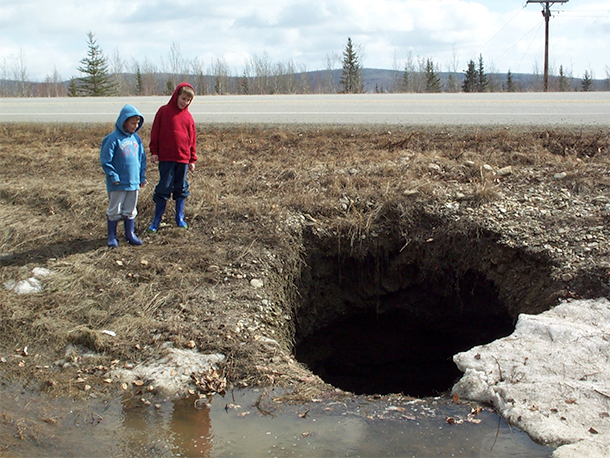
Vladimir Romanovsky’s sons surveying a sink hole in Fairbanks, Alaska. (Photo: V. Romanovsky)
CURWOOD: From the Jennifer and Ted Stanley Studios in Boston and PRI, this is Living on Earth. I’m Steve Curwood. The Arctic is warming twice as fast as the rest of the planet, and it is mostly a vast ocean, with little more than half the summer ice it used to have just a few decades ago. We’ll have more on the economic and national security implications of the warming Arctic Ocean, but first consider the frozen lands around it.
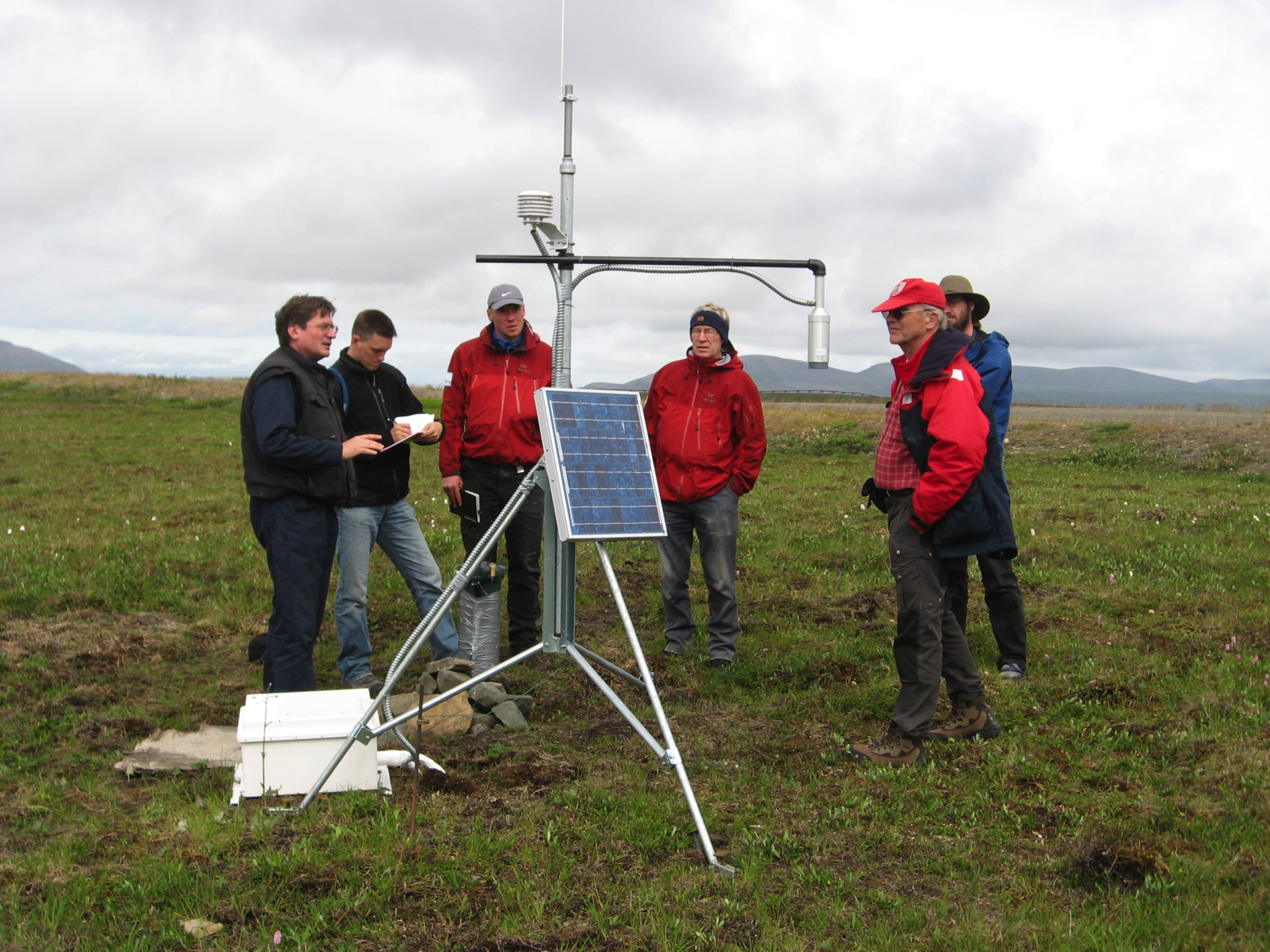
North Slope, Alaska, Vladimir Romanovsky works with collaborators from Denmark to check the temperature of the permafrost. The temperature is between -3 and -3.5 C, which could induce melting. (Photo: S. Marchenko)
Permafrost, ground that has been solidly frozen since the last Ice Age thousands of years ago, is beginning to turn to mush. As permafrost warms it releases greenhouse gases in the form of CO2 and methane, and a recent paper in the journal Nature suggests the climate may be headed for a tipping point. The warmer the permafrost gets, the more carbon is released into the atmosphere, which then promotes more warming, releasing more carbon, and so on. This feedback effect could possibly trigger runaway global warming, as early as 2050. And one sign of the changing tundra is already here, with the appearance of weird craters in Siberia. Vladimir Romanovsky is a geophysicist at the University of Fairbanks in Alaska, and we called him up. Welcome to Living on Earth.
ROMANOVSKY: Yeah, thank you.
CURWOOD: So what do these craters look like?
ROMANOVSKY: Well, that's a pretty large hole in the earth. It's about 30 meters, like almost 100 feet in diameter, and it's kind of a round shaped hole, and it goes down to up to maybe 40 meters so it's more than a hundred feet in depth. And it's surrounded by some material which it looks like it was so thrown out of this hole, and that part is the most unusual.
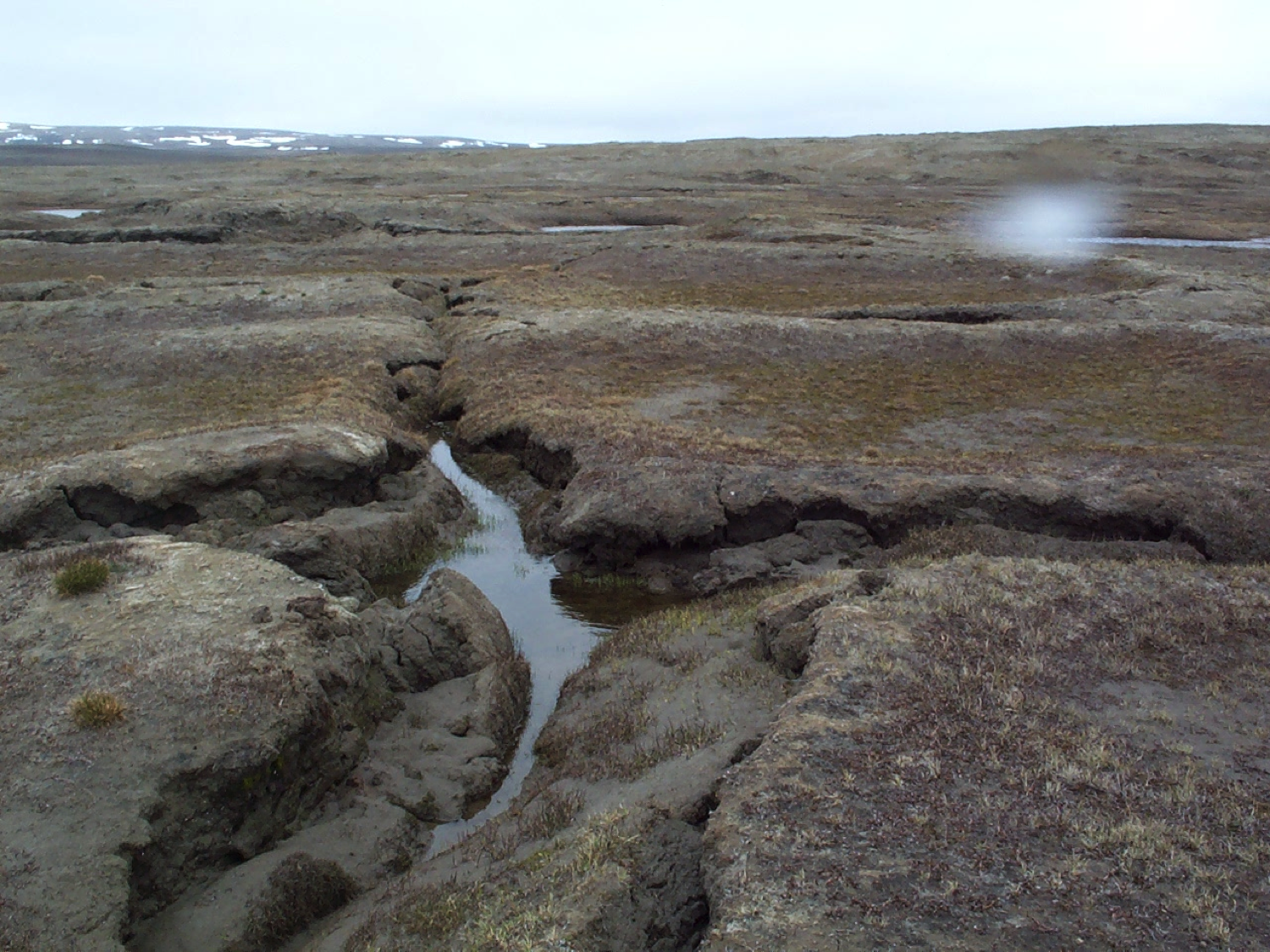
A thermokarst -- a land surface characterized by irregular surfaces of marshy hollows and small hummocks formed when permafrost thaws. This is the result of a thaw in the Canadian archipelago in the high Arctic, where permafrost is degrading. (Photo: V. Romanovsky)
CURWOOD: So it sounds like some kind of explosion perhaps?
ROMANOVSKY: Well the groups that were visiting that...they couldn't find any evidence of fire there, so any evidence of real explosion. Otherwise you would see some charcoal and some other evidence of burning, of fire. So it looks like more like very high pressure, which pushed material out of it and throw it away as far as up to 100 yards from the hole.
CURWOOD: So what could do that? That's a lot of material going a long ways. I mean, if it were bottle of champagne it would have an awful amount of bubbles to push out a cork like that.
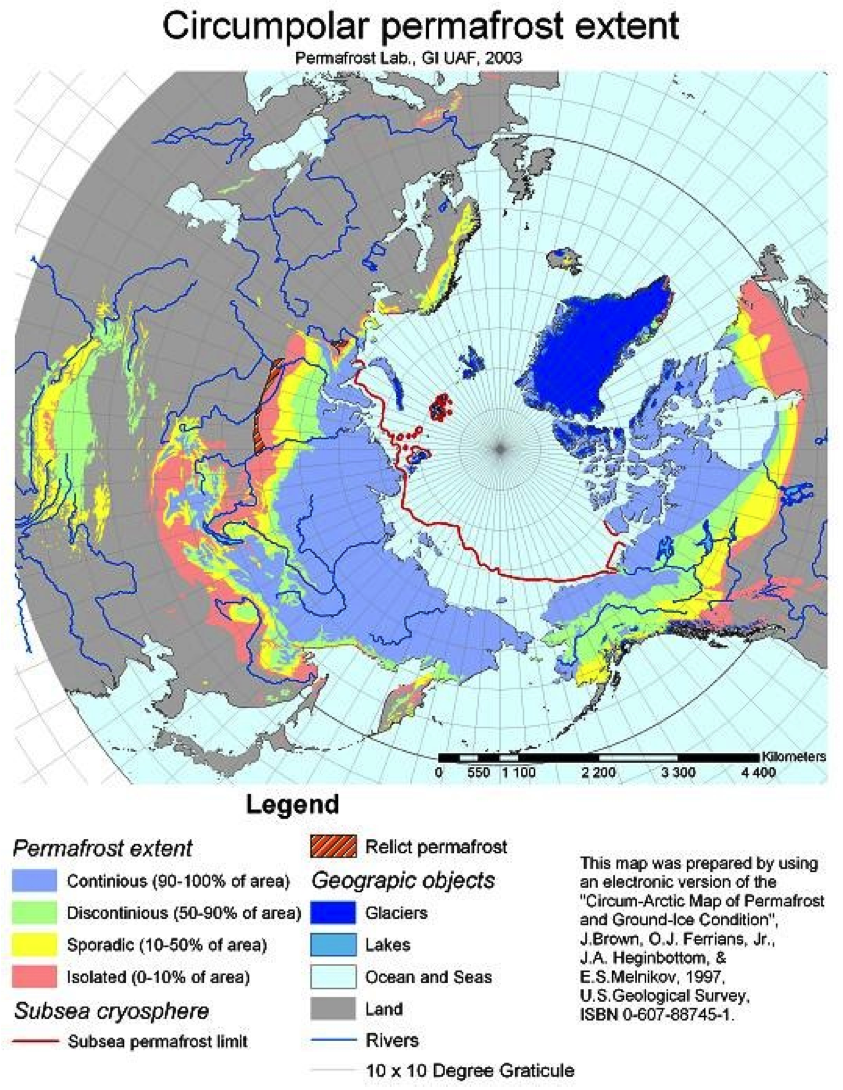
Circumpolar permafrost extent as of 2003 (Photo: Courtesy of V. Romanovsky)
ROMANOVSKY: Right, right. So you have to have really high pressure, and in my opinion the hole was actually developed steadily. So my hypothesis here is that for some period of time, and it could be pretty long time, it could be decades, maybe even centuries, the hole was developed from the bottom up from below the permafrost. Because of pressure, because of some fluids, gases, they slowly were penetrating into permafrost, developing this void in a column shape and of course this void was under pretty high pressure, because of methane, because of the decomposing gas hydrates if they are there and this development was continuously going up and up and up. And when hole was close to the surface, the roof maybe just only 10 meters thick, then pressure was big enough to push this roof up and develop a small mound because we know that before the eruption it was a mound there and eventually when the pressure was higher than strength of the material, the top of this mound just was thrown out, ejected.
CURWOOD: So, how is this related to climate change or is it related to climate change?

The shaded areas are where permafrost is predicted to thaw by 2050. (Photo: Courtesy of V. Romanovsky)
ROMANOVSKY: Yeah, I think in my explanation, climate change is one of the major factors here because to make this process going and especially to bring this hole close enough to the surface to make this eruption you have to have pretty warm permafrost and in that area permafrost, well it’s not really cold but it’s about minus 4, minus 3 degrees Celsius, and at this temperature it probably couldn't happen but the latest warming which is going on in this region for the last more than 30 years, make permafrost one or even two degrees warmer than it was originally. In this case this hole could actually reach very close to the ground surface because of permafrost's warming and this hole is continuously going up because of warmer permafrost. So in this case, warming permafrost is a necessary condition to actually develop this kind of feature.
CURWOOD: Why do you think we should be concerned about the appearance of these holes in the permafrost?
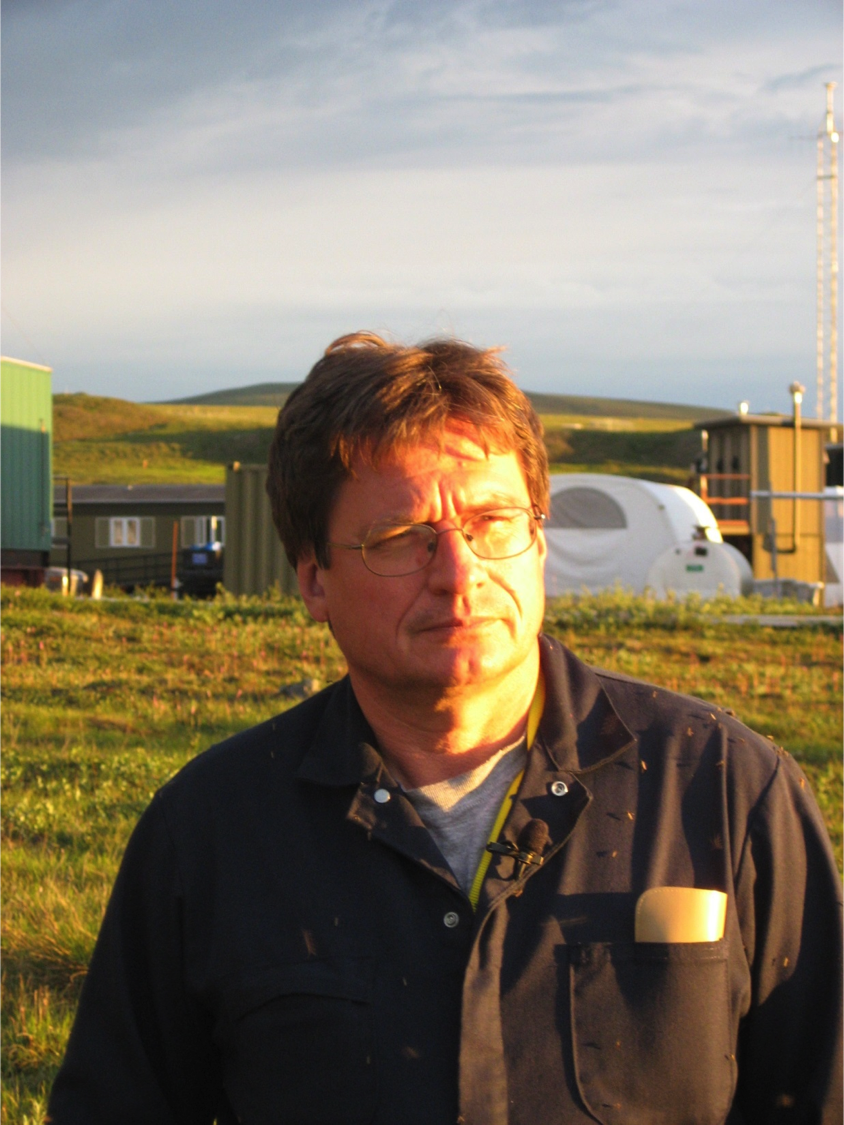
Vladimir Romanovsky at Toolik Lake Station at North Slope, Alaska, a research facility funded by the NSF. (Photo: S. Marchenko)
ROMANOVSKY: Well, because they can destroy any kind of infrastructure. It could be infrastructure related to gas and oil development, for example a pipeline, or destroy a building or infrastructure related to, well, just local communities as well. And with further warming we will have this more and more common and exploration and also extraction of oil and gas in the Arctic, put some additional pressure on permafrost. And permafrost is getting warmer not only because of warmer climate but because of human activities in that region as well. So it's kind of human activities put pressure on permafrost, permafrost degrading, developing pressure inside of permafrost and this pressure reflecting back to humans who started this process.
CURWOOD: A feedback loop there, huh?
ROMANOVSKY: Yeah, it's definitely a feedback loop here, yeah.
CURWOOD: Vladimir Romanovsky is Professor of Geophysics at the University of Alaska in Fairbanks. Thanks so much for explaining to us the possible link between Arctic melting and the mysterious craters in Siberia.
ROMANOVSKY: Very welcome and thank you for inviting me.
Related links:
- Permafrost articles published in Nature Journals
- More on Siberian craters
Leading at the Top of the World
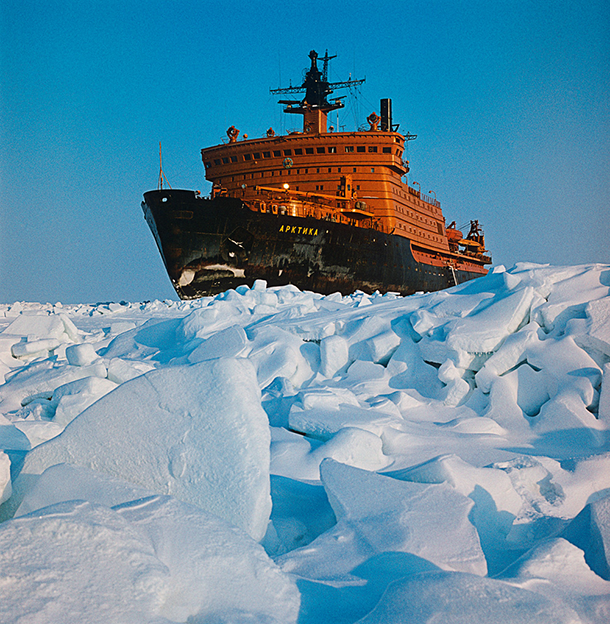
The Arktika is a class of nuclear-powered icebreaker developed by the Murmansk Shipping Company and now operated by the Russian government. As the largest and most powerful icebreakers ever constructed, they are often used to escort smaller ships through the Arctic Ocean. (Photo: RIA Novosti archive, image #186141 / Nikolai Zaytsev; Wikimedia CC BY-SA 3.0)
CURWOOD: The warming of the Arctic is front and center at the Arctic Council, the official diplomatic forum for the eight nations at the top of the world: Iceland, Denmark, Norway, Sweden, Finland, Russia, Canada and the US. The United States has just begun a two-year term as chair of the Council where there is much cooperation but also tensions over the emerging sea lanes, oil and gas extraction, research and the need to address climate disruption. For some insight on the challenges facing the US in this new role, we turn to Mead Treadwell, a former Chair of the US Arctic Research Commission who just finished a term as Lieutenant Governor of Alaska in December. Welcome to Living on Earth, Governor.
TREADWELL: Steve, it’s great to be back with you.
CURWOOD: Now, there are a bunch of issues involved here. There's resource development. There's new shipping lanes that are opening up. There's security questions. There's the climate. There's governance. Governor, what's your top priority for the council and how can US leadership affect that?
TREADWELL: Well, Steve, I've always said that the Arctic is a brand new ocean, and if we don't use this ocean responsibly, we don't deserve to be there, and so we need, as shipping comes to the north and people have been trying to bring shipping to the north in a major way for 500 years or more of exploration, we need to do it right, and that means having ships that are prepared for ice conditions, it means having ice breakers and tugs and ports of refuge. We have to be aware of procedures in the Law of the Sea that would help us get safer shipping. Article 234 is an example that basically gives us power that no other coastal state would have to protect against oil spills from itinerant ships going through. And the US needs to make investments and understand that it, too, is an Arctic nation.
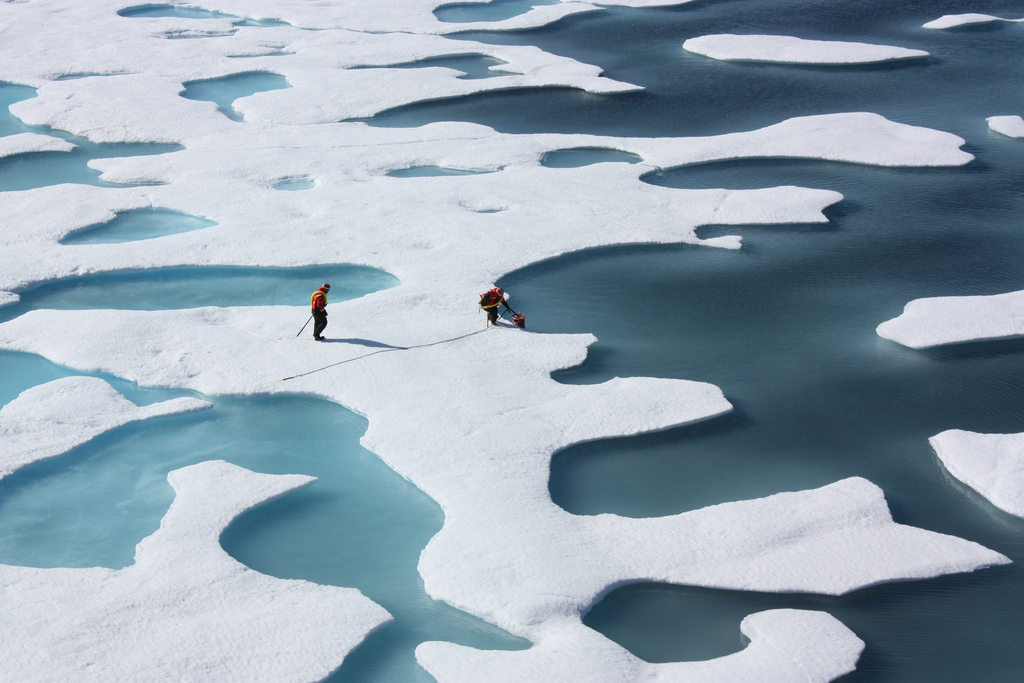
Global warming is causing the arctic to warm faster than any other region in the world. One of the outstanding symptoms of this is the Arctic Ocean’s thinning sea ice. (Photo: NASA Goddard Space Flight Center; Flickr CC BY 2.0)
CURWOOD: Now, as I understand it, the United States doesn't have nearly the icebreakers that the Russians have, and we don't seem to have the resources for the Coast Guard to deal with the safety and even military issues that might come up. What do you think we should do?
TREADWELL: Well, I think we need permanent forward basing for the Coast Guard. They have been using temporary facilities in Barrow and Kotzebue and Nome. We need icebreakers for the Coast Guard and there's the concept of a billion dollar new Battlestar Galactica icebreaker. I don't think we need that. I think we need several smaller icebreakers that you could probably get faster by leasing them. I think we need rules that make sure that ships going through are prepared for oil spills, have done the prevention work for oil spills, just like we have for domestic shipping. We ought to have a cooperative shipping regime in the Arctic to pay attention to it the same way that we paid attention and got the Panama Canal built.
CURWOOD: Governor, what about oil and gas? I've seen articles that say that some 30 percent of the world's gas reserves, perhaps some 13 percent of the world's estimated oil reserves are there. But it's kind of tough to get them out. How safe is it to go after all this stuff?
TREADWELL: Well, I guess I can say that of the five Arctic states, all of us are trying it one way or the other. The Norwegians have been drilling in the North Sea for many years. We've had drilling in the Chukchi Sea and the Beaufort. The Russians are drilling and have made major finds in the Kara Sea. Iceland has even been leasing its offshore areas and so has Canada and Greenland. So were all working on it together. We've done our best to share best practices, and we got a major exploration program we hope happens here in the Chukchi Sea this summer.
CURWOOD: Now, some would say that should there be any kind of major spill up there that we don't have the gear, nor even the expertise to deal with it. What would you say in response?
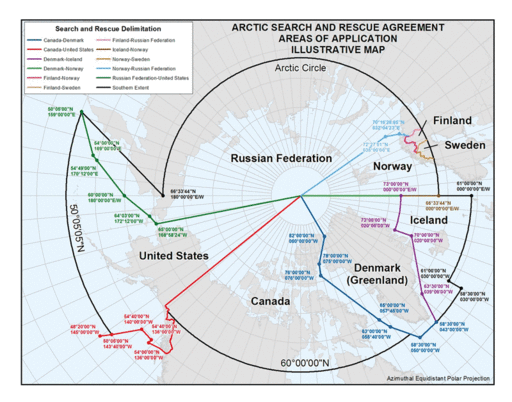
Hundreds of people travel through the Arctic on a daily basis, and in the case of an emergency, the Arctic Council created a search and rescue agreement delineating emergency response responsibilities. (Photo: Wikimedia Commons)
TREADWELL: Well, if we don't have the gear in the United States, you're not allowed to drill. So the oil companies coming to the table have to come with the major response contractors and so forth. As chair of the Arctic Research Commission, we wrote several reports, made major recommendations to the White House that we improve and get the US government more involved in the joint industry programs that are working to improve oil and ice response. At the same time, the federal government has rewritten its regulations in terms of what requirements are on the oilrigs themselves. So, we're constantly pushing this envelope, but I do believe it safe enough to explore and I don't think we can just flatly say don't do it. There are six Arctic nations working to explore for oil. I’d say get together and do it properly.
CURWOOD: Now, there are another eight countries in the Arctic council, with a number of other countries want a say in all this. What about the other countries of the world who want in?
TREADWELL: Well, officially, these countries are called observers. I think of them as Arctic partners, and, Steve, look at it this way. Whatever we do among the eight Arctic nations or the people who live in the Arctic region, we're not going to deal with some of these massive global problems without other large players sitting at the table. So the fact that China is now an observer - Singapore, India, Japan, Korea - and I guess I would say that what these countries are interested in is being partners with Arctic nations to make sure that what happens in this ocean happens right, and to be there as the rules are set.
CURWOOD: You mentioned, and the State Department often mentions, the importance of the Law of the Sea convention when it comes to global ocean issues, yet the US is not officially member of the Law the Sea Treaty process. How would you vote in the Senate if you were there if it were to come up for ratification and why?
TREADWELL: Well, I support the procedures in the Law of the Sea that affect us in the Arctic. I'm not sure I support the procedure in the Law of the Sea that has us pay a tax to the International Seabed Authority for offshore development anywhere a US company is working, and that's been what's held it up. It has not been the Arctic issues; in fact, there is a general consensus that we need it in the Arctic. That, as other nations are making claims for vast areas of the bottom of the Arctic Ocean, we need to be there and make our claim. There is freedom of seas embodied in Law of the Sea and it would help us get to remove the small disputes that we have Canada and Russia on internal waters versus international waters. The Law of the Sea has got other things in it that need to be fixed. One big concern that I have for researchers is that Russia has not been very welcoming of research inside its 200-mile limit and as they get control of land all the way to the North Pole on the ocean bottom, it's going to make it very hard for climate research by other nations without Russia. So I'm hopeful that negotiators on Law of the Sea might come together and work on access for research on the ocean bottom. So it may be time to address some of these issues and in another convention. I'm not sure.
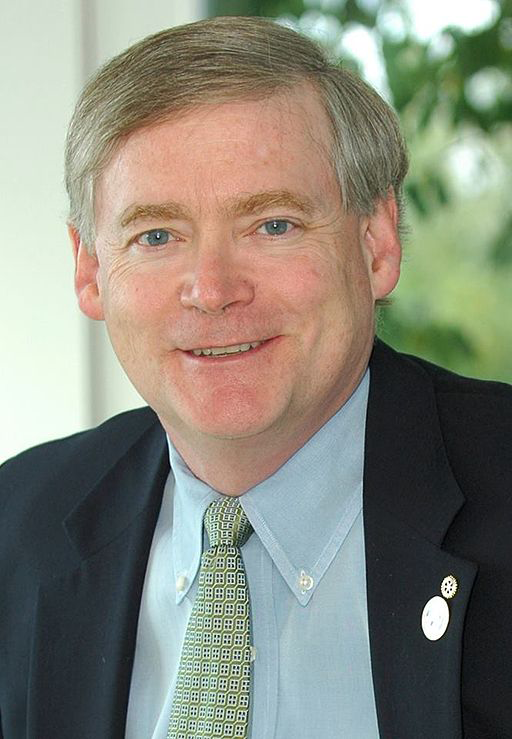
Mead Treadwell (R) was Lieutenant Governor of Alaska until 2014, and is a past Chair of the US Arctic Research Commission. (Photo: NorthernAdamantium; Wikimedia CC BY-SA 3.0)
CURWOOD: Now, what about fishing in the Arctic?
TREADWELL: You know as the climate changes more and more fish stocks may be moving north, and the US has a moratorium on high seas fishing in its 200 mile limit, and I'm very glad about Ambassador David Balton has also brought the Arctic countries together to see if we can make sure that we do science before we allow commercial fishing. Over the last decade or so we've brought together scientists from the Barents Sea with scientists from the Bering Sea for example, and Russian scientists and Canadian scientists. So the fact that high seas fishing agreement in the Arctic is under consideration to me is very important.
CURWOOD: And, so far, what successes would you point to of the Arctic council?
TREADWELL: Oh, I'd say lots of successes. You know, early on, back before climate change was probably the largest issue, we were very concerned, Steve, about contaminants. So the council has had for a long time an Arctic monitoring and assessment program so that we can help fight transboundary pollution and I think that's been positive. The first binding agreement of the Arctic Council was a search and rescue agreement. Tens of thousands of people fly through the Arctic every day between Europe and Asia, North America and Asia, and the countries sat down in 2011 and divvied up the Arctic to assign responsibility for search and rescue. The oil spill agreement does not do as much in the way of prevention as I had hoped, but there's a number of other social issues that just in our small neighborhood at the top of the world have been addressed and need to be addressed. We have a very high suicide rate among young people, especially young men, and that is not just in Alaska, but it's in another Arctic regions, so we're sharing expertise on that. Another thing that I think is very important is protection of native languages, and we are sharing expertise on that. We're working on food security, we're working on lowering cost of energy, we're working on the suicide and the health issues, so in the close to 80 projects that these governments are doing together in the north, we are building a neighborhood, and despite the challenges that the United States has with Russia today and the west has with Russia today we are continuing cooperation at the top of the world.
CURWOOD: Mead Treadwell is former Republican Lieutenant Governor of Alaska, and has served in the past as chair of the US Arctic Research Commission. Thanks for taking the time with me today.
TREADWELL: Thanks, Steve, and we’ll see you at the top of the world.
Related links:
- http://www.newyorker.com/tech/elements/siberia-mystery-craters-methane-climate-change
- US Dept of State's involvement with the Arctic Council
- US Arctic Research Commission conducts research and advises the US government on arctic issues
- UN Convention on the Law of the Sea
- Overview and history of UN Convention on the Law of the Sea
[MUSIC: Glenn Miller and his Orchestra, I’m Sitting on Top of the World, The Glenn Miller Story Vol 1-2 Avid Entertainment, 2014]
CURWOOD: Coming up...good and bad news about the sea life in the Pacific Ocean. Stay tuned to Living on Earth.
[CUTAWAY MUSIC: Dick Hyman Group Featuring Howard Alden, I’m Forever Blowing Bubbles, Sweet and Lowdown 1999]
Illuminated Fishing Nets Prevent Bycatch
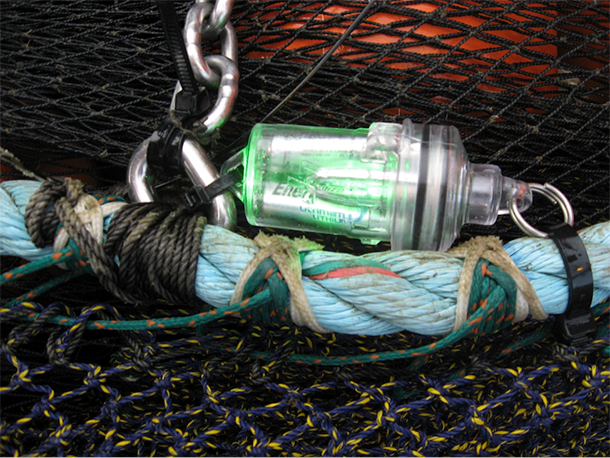
One of the lights attached to a shrimping net. Bob Hannah estimates that these lights will pay for themselves quickly, since eliminating bycatch allows fishermen to keep more of their nets of valuable shrimp. (Photo: Stephen Jones, Oregon Department of Fish and Wildlife)
CURWOOD: It’s Living on Earth. I’m Steve Curwood. The waters off the coast of Oregon are teeming with delectable pink shrimp. But shrimpers often also scoop up fish they didn’t want, what’s known as “bycatch”, in particular a smelt called the eulachon. And that is costly for the eulachon, and the fishing boat operators. Now government scientists have discovered a nifty way to cut the eulachon bycatch using LED lights. Bob Hannah of the Oregon Department of Fish and Wildlife told Living on Earth's Emmett FitzGerald all about it.
FITZGERALD: So, first off, tell us a bit about this fish. What is a eulachon?
HANNAH: Yeah, it's a neat fish. It's also called the candlefish. It's an anadromous smelt, lives in the ocean, but it runs up rivers like the Columbia to spawn, and it's been harvested by lots of people for many years, including Native American tribes for food and other uses.
FITZGERALD: And so when did you first notice that these fish were getting trapped in shrimping nets?
HANNAH: These fish have been a bycatch in the shrimp fishery since day one when the fishery began in the ’50s. In fact, fishermen invented smelt belts to sort them out in the ’80s because they were so abundant at that time.
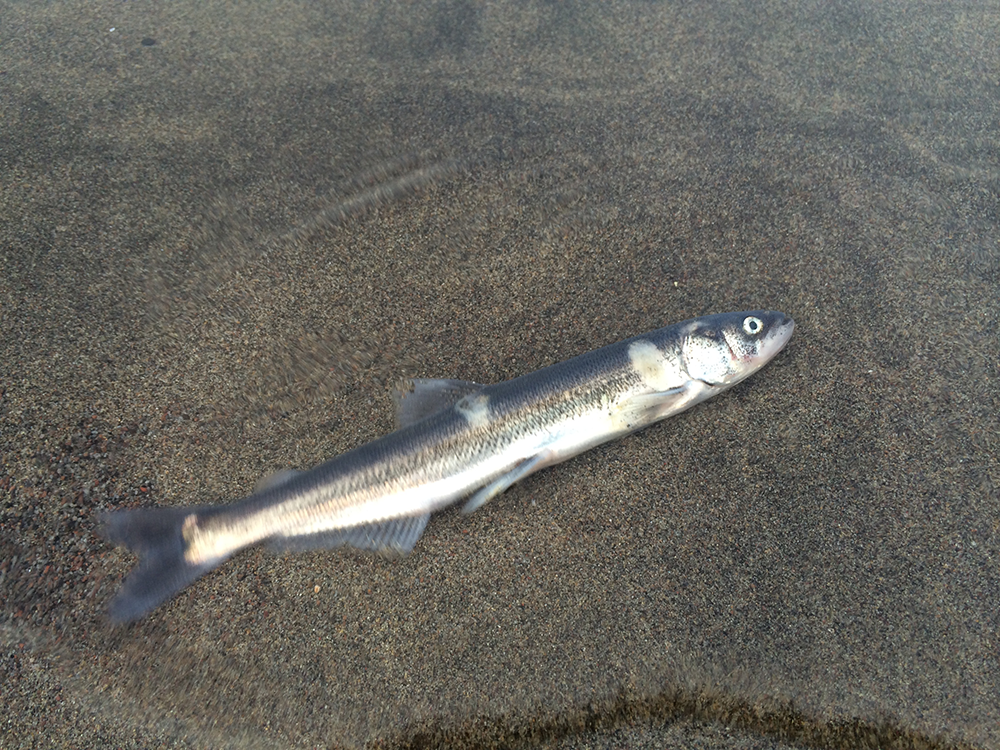
The Eulachon is a small smelt species of fish. (Photo: Sam Beebe, Flickr CC BY 2.0)
FITZGERALD: And what's a smelt belt?
HANNAH: Smelt belt. It's a rotating sandpaper belt that's part of their deck gear, shrimp slide down them but the smelt stick and they're pulled up and go out a trash chute. They've been abundant enough to require mechanized sorting for a quite a long time.
FITZGERALD: And so, now, fisherman in Oregon have been using grates also in their nets to sort of exclude some of the fish like the eulachon, that they don't want to prevent that bycatch. How do those work?
HANNAH: Well, they work very, very well. They're an inclined panel of vertical bars that sort the large fish out. They go out the top, out of the net and let the shrimp pass through. They work very, very well on large fish. They also work, to some degree, on eulachon and other small fish, but it still left a fair amount of bycatch in the catch.
FITZGERALD: So how did you come up with the idea to use lights to light up these fishing nets?
HANNAH: Well, it was a little bit by accident, a little bit by design. We had done some camerawork, underwater camera work, to look at the behavior of the eulachon as they were being excluded from the trawls. We wanted to make sure they were in really, really good condition and that they weren't just being completely stressed out before they were excluded from the trawls. And we wondered how the lights of our camera system were affecting what we were seeing and so we decided to test what the effect of light was on the exclusion efficiency. So we came up with this light experiment. It was funny. Our hypothesis going in was that if we put these lights around these grates, that more eulachon would go out of the net, and the exact opposite happened. More of them went through the grate and ended up getting caught, in fact, it about doubled the bycatch. Fortunately for us, we also had decided to try them up on the footrope at the front of the trawl, right where the netting attaches. And the nets in this fishery run about 18 inches to 24 inches above the seafloor, so there's a big space underneath for fish to go through. They just won't use it a lot of times.
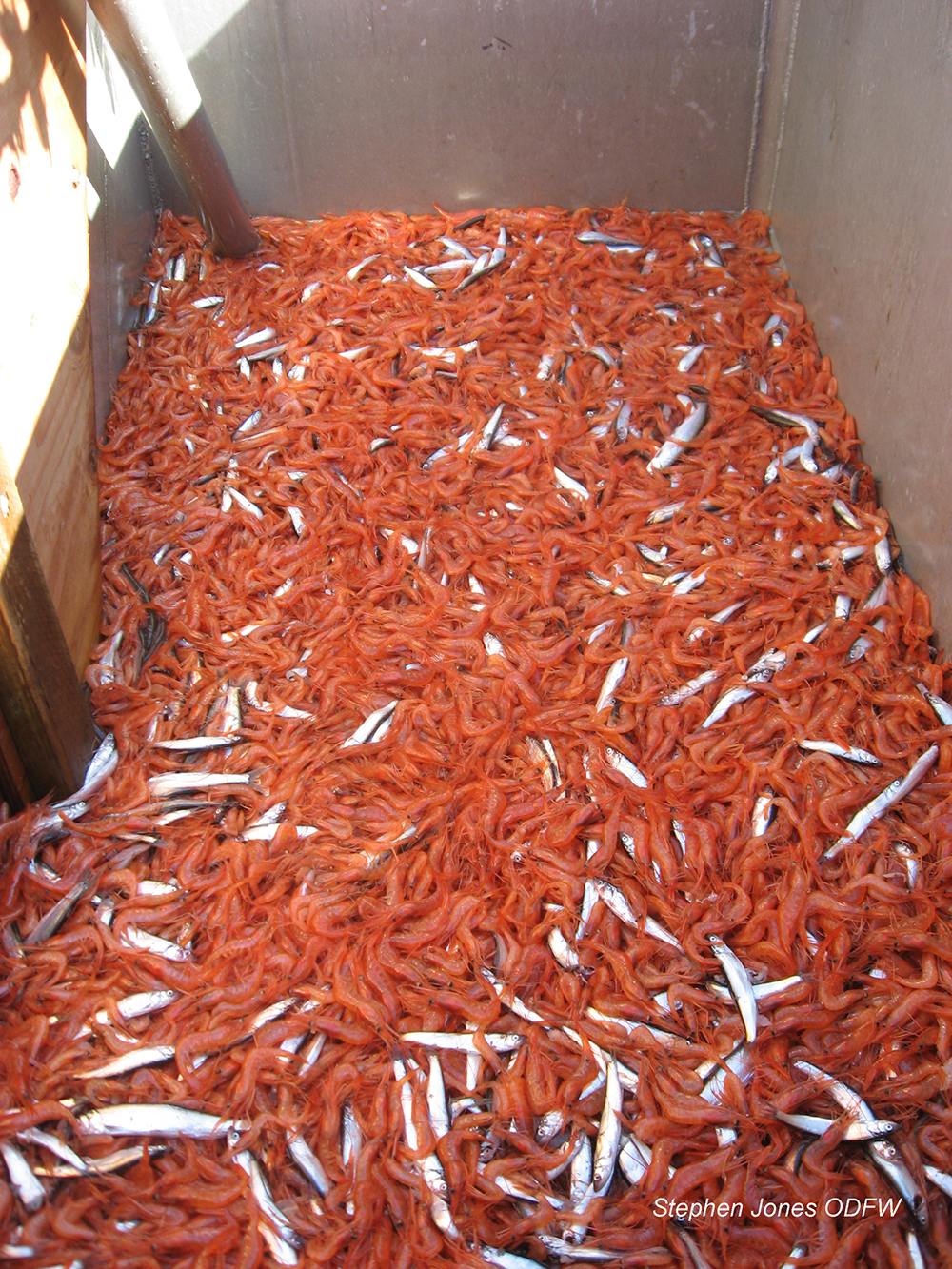
Shrimp catch (and eulachon bycatch) without lights (Photo: Stephen Jones, Oregon Department of Fish and Wildlife)
FITZGERALD: And so what did you find? So when you put the light to the front of the net what was the impact on bycatch?
HANNAH: Wow, it was amazing. These vessels are double rigged. They're on two nets at one time, so it's really nice...you put lights on one net, no lights on the other. You dump the catches into a divided hopper, and you can see immediately the difference. When we dumped our first tow with the lights up on the footrope it was amazing. There was quite a bit of fish in one side with the shrimp and the other side was basically nothing but shrimp. We all looked at each other, we knew something very significant had just happened unless it was just a fluke. So we did a few more tows and we moved the lights from one side, one net to the other and every time we moved the lights to that side, all of a sudden the vast majority of bycatch didn't show up in the net. So that evening - we finished seven tows that day, that evening were sitting around the dinner table and the skipper was skimming the boat toward shore. I didn't really know why but I was so focused on my dinner. We get inside cell phone range and he picks up the cell phone, calls his wife and orders $2,000 worth of these lights. When he got off the phone I asked him “are those to pay for themselves?” and he says “probably in a day”. If you have a lot of bycatch in your net sometimes you have to dump the whole tow and have to dump 3, 4, or 5,000 pounds of shrimp and 50 cents a pound that covers the lights.
FITZGERALD: So, Bob, tell me what you think is going on? What about having the lights in the front of the nets is enabling the eulachon to avoid becoming bycatch?
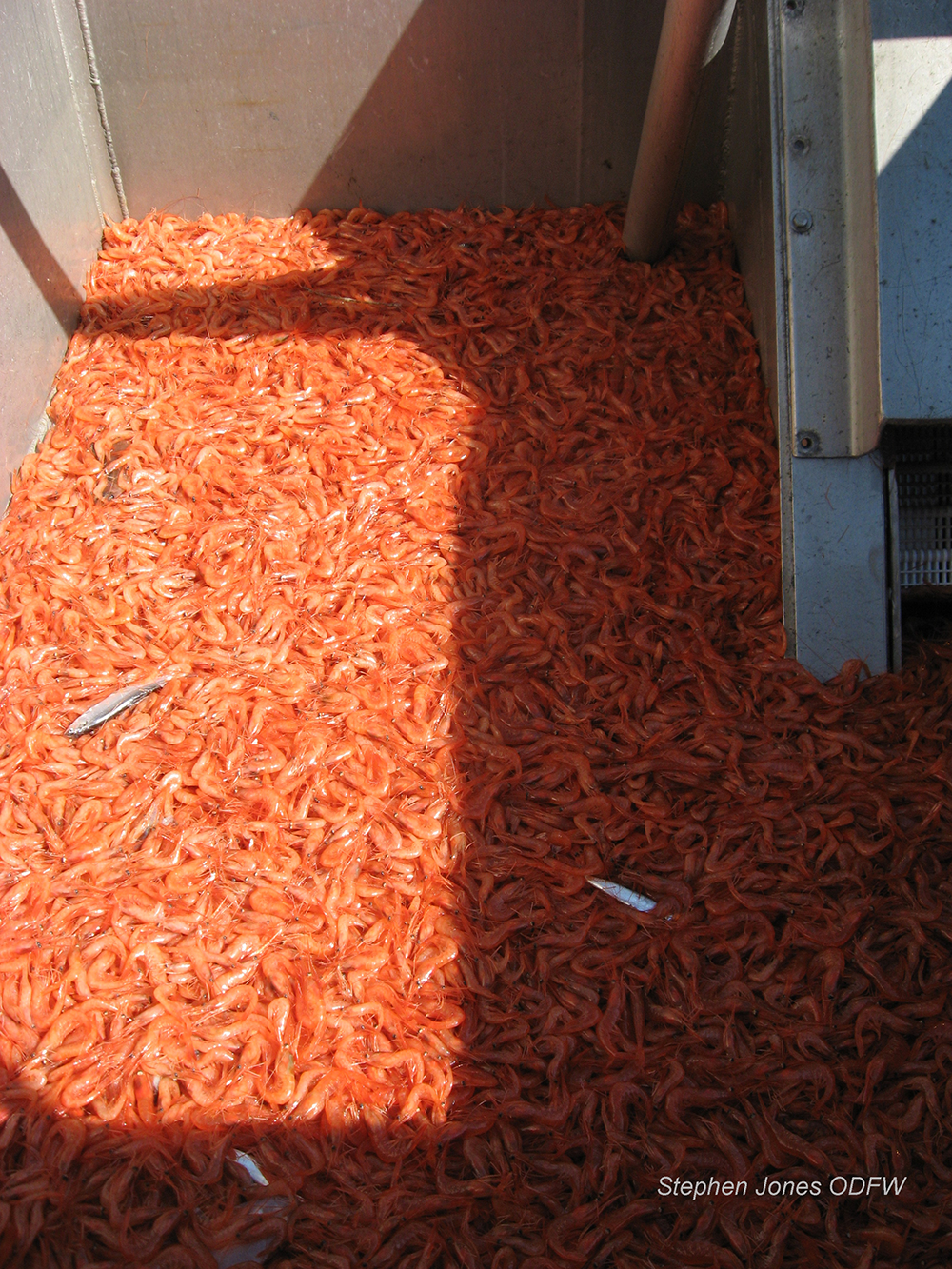
Shrimp catch with the lights. (Photo: Stephen Jones, Oregon Department of Fish and Wildlife)
HANNAH: Well, OK, here's our working hypothesis. The shrimp fishery works at pretty deep depths, 60 fathoms up to 140 fathoms. So there's not much light on the sea floor. It's virtually dark. So what we think is happening is: the fish react in what's called an opti-motor response. They just avoid an approaching object even if they can just barely see it. You think that in both cases at the grate and at the front of the trawl adding a light allows the fish to navigate through a confined space in the back of the trawl that they go through the grate and I think they can see that there's something back there that they're comfortable going to. I think at the front they see that there's a space between the net and the seafloor that they can get through and get back to sea floor so I think it allows them to utilize escape routes that are there.
FITZGERALD: So you're basically just using a little bit of technology and giving them a hand to save themselves.
HANNAH: Yeah, but it's very interesting in it's kind of a cool thing because it's been known for a long time that in the day and the night fish react differently to approaching trawls and inside the trawl. And now what we've shown is that by adding a light you can alter the effect in a low light situation in terms of how they respond to the components of the trawl. So it may have applications in other fisheries to get the fish you want out of the trawl, out of the trawl.
FITZGERALD: So tell me a little bit about the reaction you've had from fishermen in the area. Are people excited about this development?
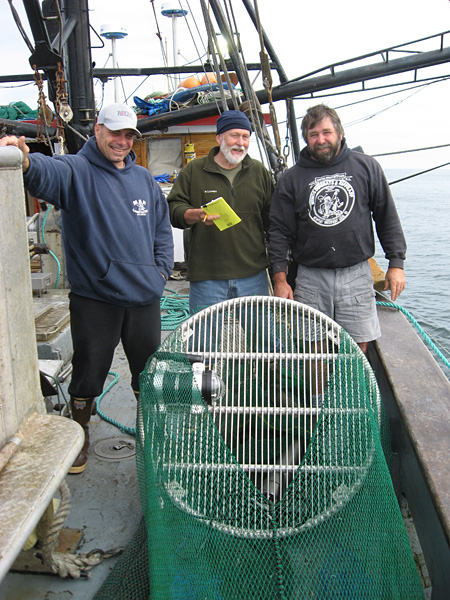
Bob Hannah (center) poses with a bycatch reduction grate (Photo: Oregon Department of Fish and Wildlife)
HANNAH: Oh, they are so excited. We did send a newsletter out to the fleet telling them, hey, this is a good thing to do. And within two months, the entire fleet virtually was using these lights. Anybody who didn't have them, had them on order, and when we surveyed the fleet back in September, October, of last year we got these written surveys and we got a lot of great comments, "Thanks for doing this”. “This is great. How did you think of this?” “We really appreciate you guys," and we're still getting comments like that from people who are coming back into the fishery. "We're so glad you guys figured this out." And I don't think that's coming from an overwhelming sense of conservation concern for the eulachon, I think it's coming from some of the operational difficulties that the technology solved for people who were having high bycatches.
FITZGERALD: Bob, at the end of the day what do you hope comes out of this research?
HANNAH: What I hope comes out of this, I hope that the people in a lot of trawl fisheries around the world come up with innovative ways to reduce bycatch in other fisheries with other problems and understand better methods for motivating fish to use bycatch escape routes in trawls so that trawl fishing in general can be cleaner and more sustainable.
CURWOOD: That’s Bob Hannah of the Oregon Department of Fish and Wildlife in conversation with Living on Earth’s Emmett FitzGerald.
Related link:
Oregon Department of Fish and Wildlife’s report on the use of LEDs to reduce Eulachon bycatch
Calling Over Boat Noise Is Making Orcas Hungry
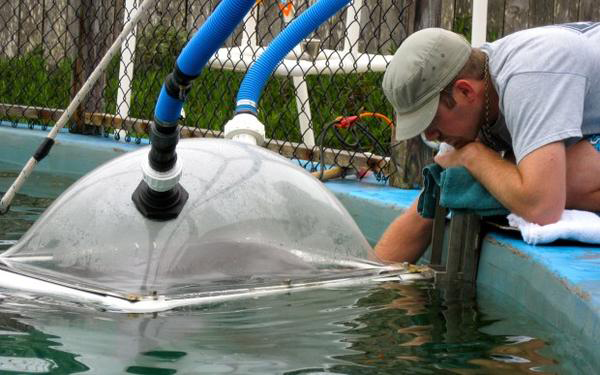
A dolphin trainer records orca vocalizations at different volumes to help scientists understand energy expenditure in the presence of underwater ship noise. According to the lab, all procedures were approved under U.S. National Marine Fisheries Service permit No.13602. (Photo: courtesy of Terrie Williams' Mammalian Physiology lab at University of California, Santa Cruz)
CURWOOD: But becoming bycatch isn’t the only problem for sea creatures off the coast of the Pacific Northwest. Undersea noise levels are increasing in the region as thousands of freighters, ferries and other vessels motor up and down the coast. And some new research details how that noise could make life harder for endangered marine mammals. From the public media collaborative EarthFix, Ashley Ahearn has the story.
AHEARN: Picture yourself at a noisy bar. You realize that you have been shouting at the top of your lungs all night in order to be heard. Well, orcas in Puget Sound are in kind of the same situation.
[LOUD VESSEL NOISE]
AHEARN: This is a recording from a hydrophone that was suctioned on to a wild killer whale in the San Juan Islands, near a passing vessel. Loud boat noise forces endangered killer whales to raise the volume of their calls. Marla Holt is a biologist at the NOAA Northwest Fisheries Science Center in Seattle.
HOLT: But the question is, OK, so they do it, so what? What are the biological consequences of them doing this?
AHEARN: To answer that question, Holt and her NOAA colleague, Dawn Noren, studied captive bottlenose dolphins. In the experiment the dolphin swims into this funny little floating plastic helmet-looking thing, that’s positioned over its head. Then the trainer asks it to make its normal whistling call for two minutes for a fishy reward.
[DOLPHIN WHISTLES]
Dawn Noren measured how much oxygen the dolphin used during those two minutes.
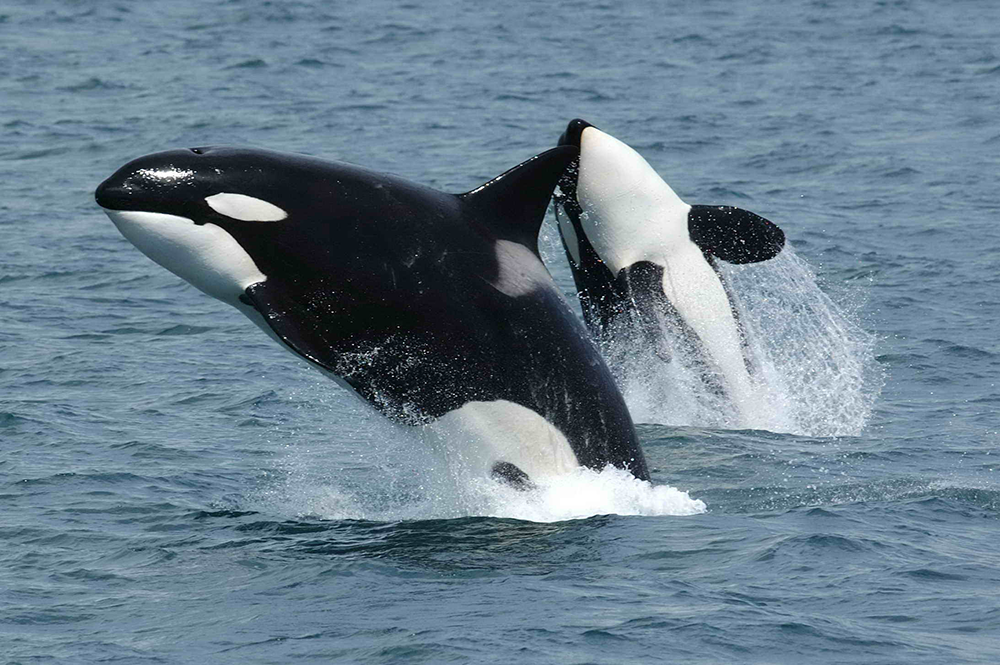
Though the killer whale (orca) species is not endangered globally, the population residing off of the Pacific Northwest’s coast is. (Photo: Robert Pittman/NOAA; Wikimedia Commons)
NOREN: And then by knowing oxygen consumption you can determine metabolic rate or how much it costs you to work, or work harder.
AHEARN: Then the trainer asked the dolphin to pump up the volume.
[LOUD WHISTLES HERE]
Making that louder call takes more energy. Holt and Noren found that when the dolphin was whistling harder and louder its metabolic rate rose by up to 80 percent above normal resting levels. And just like people, when their metabolic rate goes up, they burn more calories, so they have to eat more.
NOREN: If you have multiple incidences where you’re increasing your vocals to compensate for a noisy environment, you could have some increased need to find more fish.
AHEARN: The scientists say that when wild orcas are around loud ships, the volume of their calls increase by the same amount, or more, than the dolphins in the lab. That could mean wild orcas need to eat more salmon to make up for the calories they’re burning to vocalize more loudly around big ships.
HOLT: The concern is that for animals that are maybe just getting by or not really getting by, we could say, this is how much more fish it would cost an animal if it was disturbed that much more.
AHEARN: Holt says that as the region considers proposals to expand coal and oil shipments, as well as Naval training activities, this research could be used to calculate specific impacts on marine mammals like endangered killer whales. There are just 81 of them left.
I’m Ashley Ahearn in Seattle.
CURWOOD: Ashley reports for Earthfix, and to be clear, while there are as many 50,000 Orcas still on the planet, the population often found near Seattle is considered endangered because of its small numbers.
Related links:
- More about orcas and noisy oceans
- Study: Speaking up: Killer whales (Orcinus orca) increase their call amplitude in response to vessel noise
Protecting Blue Whales and Blue Skies

Limiting the speed of a large ship to 12 knots or below reduces whale fatalities from ship strikes by 50 percent. (Photo: John Calambokidis, Cascadia Research)
CURWOOD: And we’ve got news of another project that might help protect whales - the “Blue Whales, Blue Skies” initiative. It’s the brainchild of a group of marine conservation, pollution control, environmental protection and shipping line interests that came together to try to clean up the air along Southern California’s coastline and at the same time reduce the likelihood of ships running into whales. Living on Earth’s John Duff spoke with Mary Byrd, of the Santa Barbara County Air Pollution Control District.
DUFF: Can you paint us a picture of the ocean area that we're talking about? How big is the area and what's going on out there?
BYRD: Well, Santa Barbara County on the coast of California has 130 miles of coastline. And just off of our coast is the Santa Barbara Channel, and the channel is home to two giants that roam the oceans of the world. One is a container ship, which comes through the channel on the way to the ports of Los Angeles and Long Beach, and the other is the Blue whale, which comes to the channel to feed and the channel is also a migratory path for a number of other endangered whale species. So these two are on a collision course and this project is all about addressing both issues for common goals.
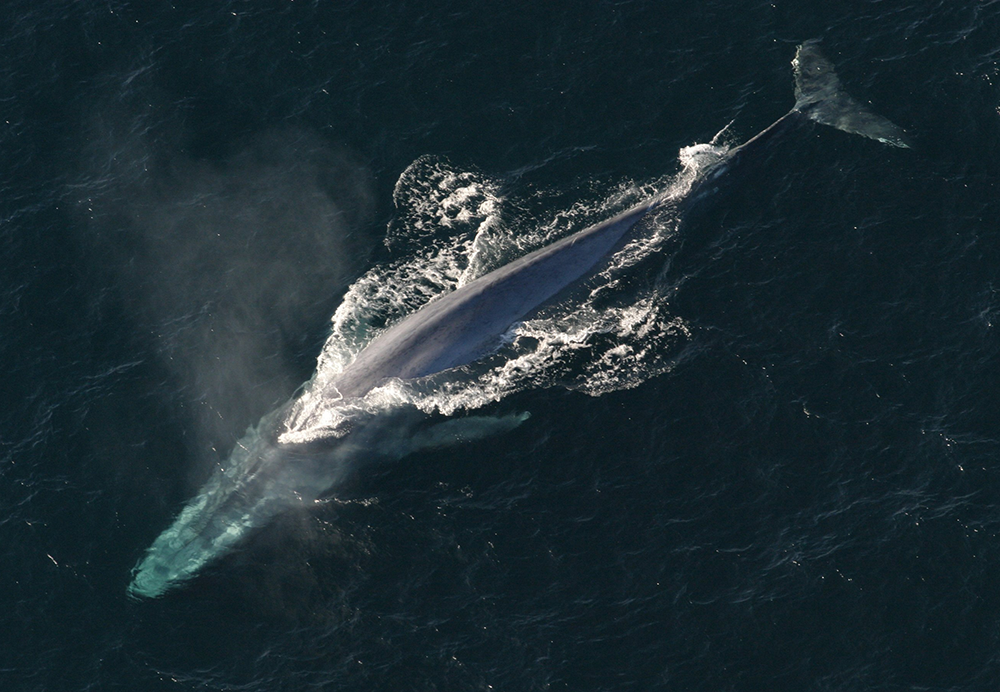
Blue whales are classified as Endangered on the IUCN Red List; in the last 100 years, their total population has decreased by an estimated 70-90%. (Photo: NOAA Photo Library, Wikimedia CC BY 2.0)
DUFF: How big are these ships?
BYRD: Well, they can be any number of sizes. These container ships have engines the size of a three-story building. It's really very difficult to see the whale from the container ship. In one case, there's a situation where a ship came into port and there was a bowfin over the bow and the captain had no idea the ship had struck a whale.
DUFF: Can you tell us how many ships are moving through that area on an annual basis and how many of the whales might be out there?
BYRD: We know the numbers vary a lot based on the shipping economy. Some years it's up to 2,500 transits through the channel. Sometimes it's much more. In terms of the whale species, there's a variety of different types of species. The Gray whales are on a migration path through the channel, now they are not considered endangered, but there are other species that are. The Blue whale comes through the channel to feed. Not that much is known about the Blue whale, and it's not clear that they can avoid the ships. When you think about it, they have not evolved to have to deal with anything larger than they are that moves.
DUFF: You work for an air pollution control district. How did you get involved in protecting whales?
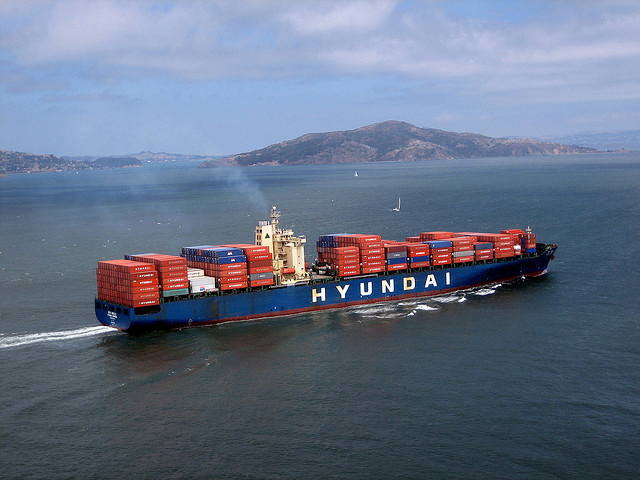
As many as 2,500 container ships travel through the Santa Barbara Channel each year, on their way between the busy Ports of Los Angeles and Long Beach. (Photo: Britt Crawford, Flickr CC BY-NC-SA 2.0)
BYRD: We have been documenting the huge amount of air pollution from ships that go through the channel. In our emissions inventory since 1994 and the NOX emissions from these ships really threaten our ability to obtain air quality standards.
DUFF: And NOX for people who are not familiar with that term is?
BYRD: Nitrogen oxides, and it's a key ingredient in the formation of ground level ozone, which we know of as smog. In Santa Barbara County we do not meet the state standard for ground-level ozone. We just barely meet the federal ozone standards and as we've gotten successful with programs onshore reducing pollution the concern grows about the shipping emissions because NOX emissions from these ships really threaten our ability to attain air quality standards.
DUFF: If you solve the ship air emission problem, do you solve the attainment problem?
BYRD: Well, it depends on how big a program we're able to fund because they do produce a significant piece of the NOX emissions in our county when we look at our inventory, and we are running out of things to do onshore to achieve the big ticket NOX reductions. So that's why we've been focusing so much energy on shipping?
DUFF: Can you tell us about the other folks involved in this program and how it works?
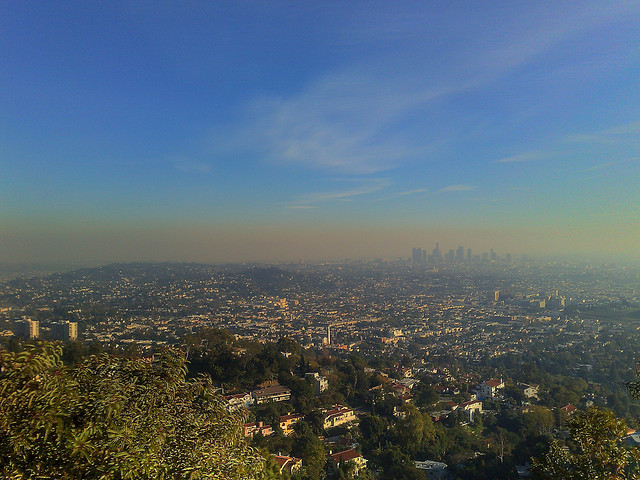
The 2014 Vessel Speed Reduction (VSR) Trial reduced nitrogen oxides and greenhouse gas emissions by 50 percent in the reduced speed zone. Nitrogen oxides, or NOx, promote ozone formation and are one of the main components of smog. (Photo: Al Pavangkanan, Flickr CC BY 2.0)
BYRD: Well, the Channel Islands National Marine Sanctuary and the Environmental Defense Center, who are two principal partners in this, have been very concerned about whale protection in the Santa Barbara Channel, and one of the things that they settled on was reducing the ship speed as a strategy to provide an immediate benefit in protection of whales. So when they came to us and said, "We have an interest in whale protection, you have an interest in pollution reduction. Let's work together," it was a great match and, in fact, the studies show when you show a ship down to 12 knots, you can cut the air pollution almost in half, and not just NOX but a range of other air pollutants as well. And the studies also have shown that when you reduce the ship's speed, you're making it much less likely that a ship strike will kill a whale. So we have a lot of common ground here to work with and we call it protecting blue skies and blue whales.
DUFF: And how fast would those ships have been going if they didn't reduce to 12 knots?
BYRD: This particular ship had to have a previous rated speed through the channel, average speed of 14 knots or greater. We provided an incentive payment of $2,500 per transit. So, they're agreeing to go down to 12 knots for the incentive payment.
DUFF: You've got a lot of interest from air pollution control districts? Can you tell us about the positive results?
BYRD: Even a small field trial like this one, we've achieved more than 16 tons of NOX reductions. The primary month where these transits happen, were July through October, which is not just the peak whale season in the channel, it's also the peak ozone or smog pollution season for our county. So it's the timing of the reduction as well as the fact of the reduction.
DUFF: Mary, you had a number of shipping lines participate in this program. Which ones and any sense of why those particular lines did it?
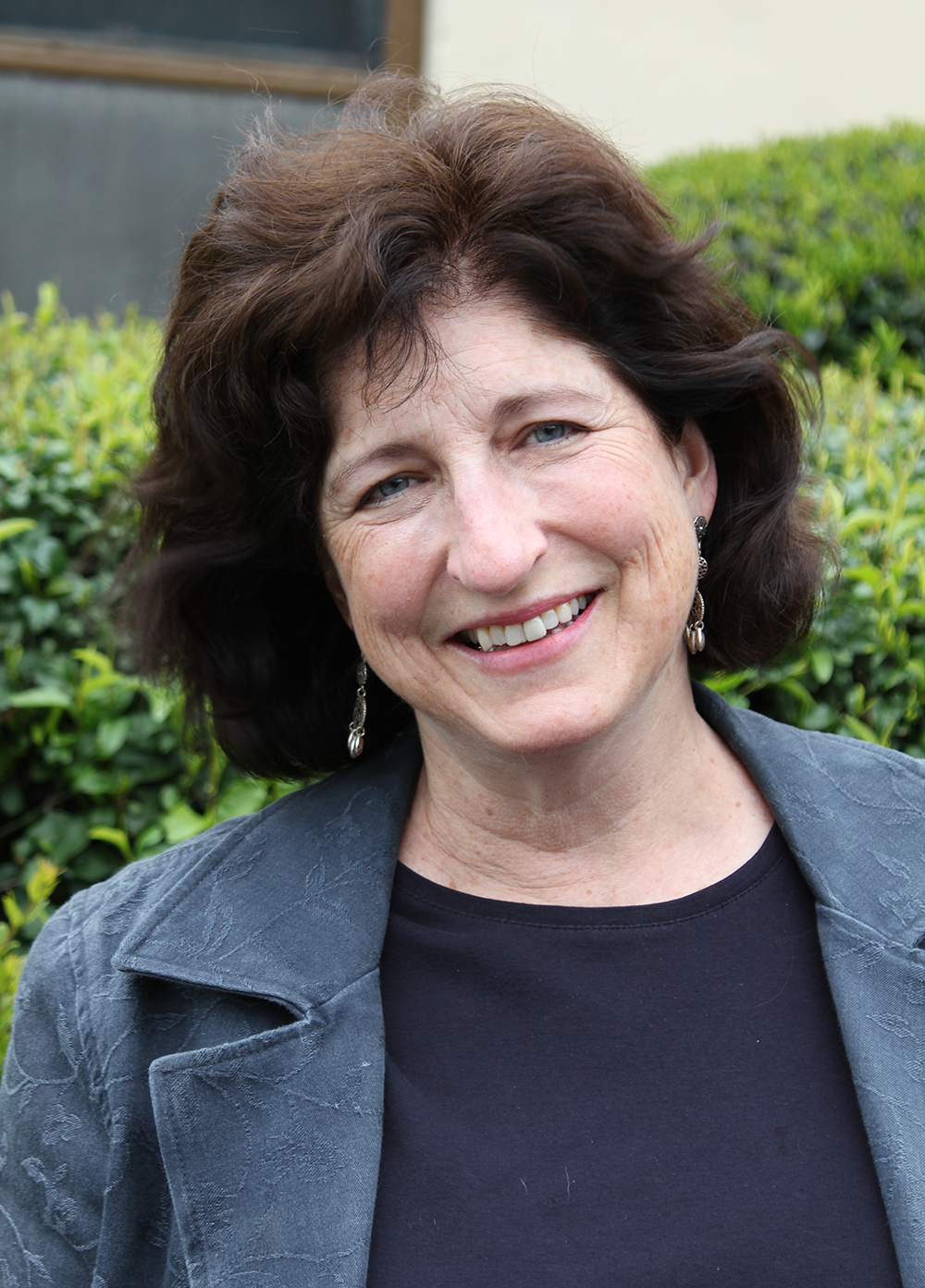
Mary Byrd is the Community Programs Supervisor for the Santa Barbara County Air Pollution Control District. (Photo: courtesy of Mary Byrd)
BYRD: We had seven global shipping companies participate and they all get credit for being a part of this program. Cosco, Hapag Lloyd, K-Line, Maersk, Matson, Mitsui, OSK Lines and United Arab Shipping Company were all a part of this. The Maersk line in particular we talked to years ago. They came and did a presentation for us to help us understand how the industry worked and the Pacific Merchant Shipping Association was extremely helpful in helping us structure the program helping us understand what the shipping industry needed. In the first year we got great participation from the shipping industry, we have documented emission reductions. We laid the groundwork that we're hoping to lay for a bigger program.
DUFF: What's next for the program?
BYRD: We would like to be able to fund many, many more transits to be 12 knots or slower through the channel, to try to grow this into a full-scale channel program, and then eventually statewide and maybe even bigger.
CURWOOD: Mary Byrd of Santa Barbara County Air Pollution Control speaking with Living on Earth’s John Duff.
Related links:
- Protecting Blue Whales and Blue Skies Program
- About Air Pollution from Marine Shipping
- Protecting Blue Whales and Blue Skies report
- 2015 California’s Progress Toward Clean Air report
[MUSIC: Oscar Peterson and Itzhak Perlman, Blue Skies, Side by Side, Telarc 1994]
CURWOOD: Coming up...a profile in courage. A conservative Republican who lost his seat in Congress in part because he called for action on climate change. That's just ahead on Living on Earth. Stay tuned.
ANNOUNCER: Funding for Living on Earth comes from United Technologies, a provider to the aerospace and building systems industries worldwide. UTC Building & Industrial Systems, provides building technologies and supplies, container refrigeration systems that transport and preserve food, and medicine with brands such as Otis, Carrier, Chubb, Edwards and Kidde. This is PRI, Public Radio International.
[CUTAWAY MUSIC: Andres Segovia, Fantasym Segovia The Great Master, Deutsche Gramophon, 2004]
Beyond the Headlines
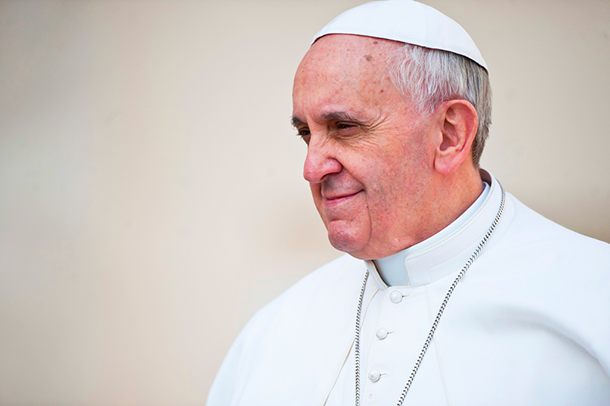
Pope Francis’ support of climate action is being met with scorn by climate deniers, who have stated that the Catholic spiritual leader is, “aligning himself with the biggest enemies of the Church and of Catholic moral principles.” (Photo: Catholic Church England and Wales, Flickr CC BY-NC-SA 2.0)
CURWOOD: It's Living on Earth. I'm Steve Curwood. Off to find out what’s happening beyond the headlines now. Peter Dykstra of the DailyClimate.org and Environmental Health News, that’s EHN.org has been digging through the possibilities and joins us on the line now from Conyers, Georgia. How are you doing, Peter?
DYKSTRA: I’m well, Steve. Let’s start with a little bit of climate change political theater that made my head explode this week. Pope Francis has made action on climate change an imperative, convening a global conference and preparing an encyclical – a major policy statement for the Catholic Church. But some of the biggest names in climate change denial are also on a pilgrimage to Rome. Their mission? To straighten out the Pope on this global warming business. So among others, Lord Monckton, the rather colorful British peer, Marc Morano, the American political operative, and the lads from the Heartland Institute – they’re the ones who put up a billboard comparing climate activists to the Unabomber a few years ago - took a trip to the Eternal City. I like to think of them as sort of the Joker, the Riddler, and the Penguin of climate science.
CURWOOD: Well, Peter, if you’re gonna go there on this issue, don’t leave out that other Batman nemesis, Mister Freeze – we could use him to fight global warming.
DYKSTRA: Good one.
CURWOOD: I take it those gentlemen weren’t exactly invited by the Vatican.
DYKSTRA: No, they weren't invited. They didn’t get a Papal Audience, but they did hold a press conference, though that didn’t get much of an audience, either. And, in advance of the trip, they buttered up His Holiness by playing the Satan Card, saying that by endorsing climate action, Pope Francis is “aligning himself with the biggest enemies of the Church and of Catholic moral principles.” Lord Monckton, a lifelong Catholic, has said that his current spiritual leader is a “climate communist.”
CURWOOD: So where many see a green pope, they’re seeing a Red Pope?
DYKSTRA: It seems so. But enough about those guys. I wanted to follow up on the interviews you had in last week’s show on this year’s winners of the Goldman Environmental Prize.
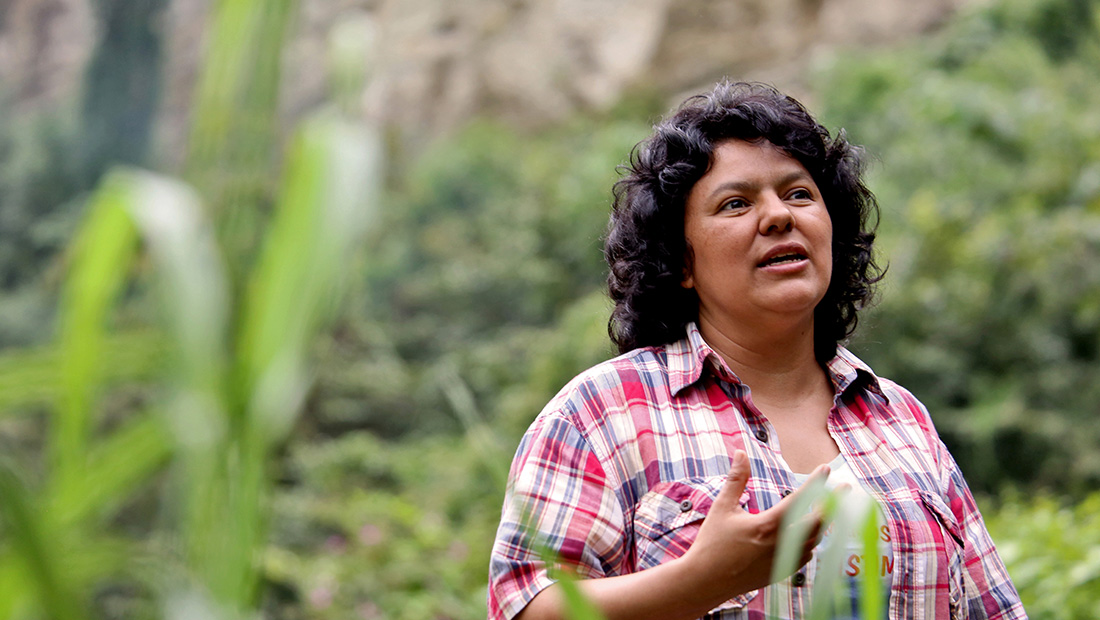
Globally, environmental activists like Berta Cáceres, a 2015 Goldman Environmental Prize from Honduras winner, have received numerous death threats and some were murdered. Those with projects in Latin America are most at risk of retaliation to their campaigns. (Photo: Goldman Environmental Prize)
CURWOOD: OK, what have you got?
DYKSTRA: So as you noted, the Goldman Prize honors environmental activists from around the world who sometimes risk their lives to protect the environment. And the human rights group Global Witness tracked 116 murders of environmental activists worldwide last year as violence greeted protests against illegal mining and logging, dam building, and other environmental threats.
CURWOOD: So that’s more than two deaths per week, for defending the environment. Where are these killings taking place, and who’s doing the killing?
DYKSTRA: About three-quarters of them were in Central and South America, with Honduras being the world’s most deadly nation for environmentalists. There, the activists say that government troops are behind the death toll.
CURWOOD: And Berta Cáceres, one of the Goldman winners this year, is a Honduran environmental leader.
DYKSTRA: Let's hope the visibility that comes with winning the prize will help keep her alive.
CURWOOD: Indeed. Take us back through the annals of environmental history.
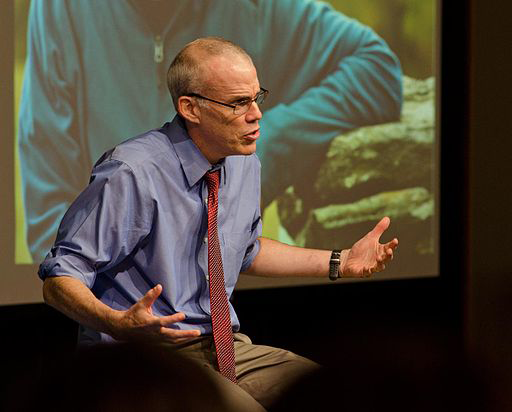
Twenty-five years ago this week, in the course of doing research for his book, The Age of Missing Information, Bill McKibben began a very unique social experiment. McKibben aimed to demonstrate the differences between human experiences out in nature and those confined to our man-made technological world. (Photo: Dave Brenner, SNRE, Wikimedia CC BY 2.0)
DYKSTRA: OK, most folks know who Bill McKibben is. Activist, acclaimed author of all sorts of books on nature and climate change, but my favorite Bill McKibben book is an obscure one called The Age of Missing Information. Twenty-five years ago this week, in preparation for the book, McKibben recruited 93 people in Fairfax County, Virginia to record twenty-four hours each of a channel on the county’s cable TV system. And then Bill McKibben watched it all: Sitcoms, preachers, game shows, newscasts, re-runs, infomercials, old movies, C-SPAN, 93 channels, 24 hours. 2,232 hours of American television.
CURWOOD: Wow.
DYKSTRA: And then he spent 24 more hours on a remote mountain in the Adirondacks and wrote about the two very different human experiences. The reason I loved this book is a very simple takeaway: the natural world, and our self-made technological world, both offer diversion and amusement and escape, and from Nature, it’s a gift. But far too often, our 1990’s TV shows, or our tweets and streaming video and Instagrams today aren’t gifted to us, they’re shoveled at us.
CURWOOD: And don’t forget, that was back when MTV had music videos, and TV news had … actual news.
DYKSTRA: And reality TV was still just a gleam in the bottom of somebody’s barrel. Of course, with all that TV to watch, he didn’t actually write the book for another two years. In a word, the difference between nature and technology is like the difference between reality and reality TV.
CURWOOD: Peter Dykstra is with EHN.org and DailyClimate.org. Thanks again, Peter.
DYKSTRA: All right, thanks, Steve. Talk to you soon.
CURWOOD: And there’s more on all these stories at our website LOE.org.
Related links:
- Pope Francis Should Answer to ExxonMobil Rather Than God, Imply Climate Deniers
- Climate Skeptics Descend on Vatican – Seek to Influence Pope on ‘Global Warming’
- How Many More? 116 Environmental Defenders Were Murdered Last Year, Mostly in Latin America
- The Age of Missing Information by Bill McKibben
[MUSIC: Masters of Reality, Rolling Green, Sunrise on the Suffers, Capitol Records, 1992]
The GOP's Lonely Climate Warrior
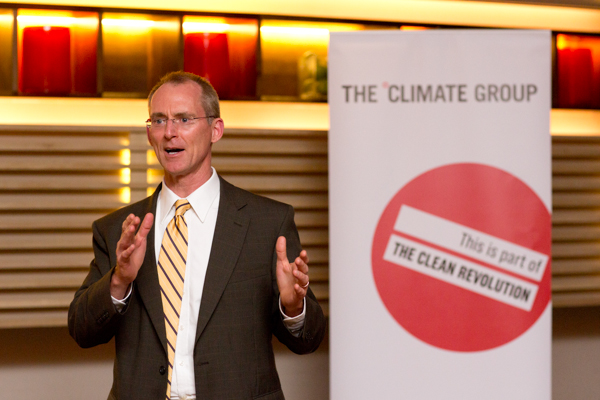
Bob Inglis (Photo: The Climate Group, CC BY 2.0)
CURWOOD: Bob Inglis represented South Carolina’s 4th District for six terms as a conservative Republican who believes in limited government, market solutions to problems and action on climate change. And that latter belief – the one about climate change -- is in part why he lost his seat in a primary election in 2010. But now that stand has won Bob Inglis a Profile in Courage Award from the John F. Kennedy Library Foundation, though he’s modest about the idea that he’s any kind of hero.
INGLIS: I think mostly the courage is to just try to lead to the future – and that comes really from having 5 kids and wanting to be able to face them and their children. Really it's about the love for them and love for those who come after us, and that's more powerful, I guess, than trying to hold onto a voting card in Congress.
CURWOOD: In announcing this award to you, the JFK Library foundation quoted President Kennedy's word "No problem of human destiny is beyond human beings" and noted that you have displayed the courage to keep an open mind and uphold your responsibility as a leader and citizen at the expense of your own political career. How ironic is it for you to get an award from one of America's most visible liberal families?
INGLIS: Well, you know, I tweeted shortly after the award that President Kennedy was a tax-cutting communist-fighting“ask not” kind of guy, I think he's a pretty good Republican actually.
CURWOOD: [LAUGHS]
INGLIS: So I'm thinking that if you go back to what he had to say about to his view of America and the role that America could play the world, he would fit right in a Republican primary in 2016.
CURWOOD: Maybe you could say he was a bipartisan in the time when in fact people did talk across the aisle.
INGLIS: But I think what's so important about the award, and it sets up another look at Conmed and asks a question in really can we accomplish really great things like we did with the moon shot with a president who was optimistic enough to believe in the people that he represented. I hope that that's the message that goes out from the award. Let's do it again just like we did the moon shot, let's do it with energy, let's reinvent energy, and we’ve got to have leaders who believe in America's ability to innovate and are ready to venture on that. Unlike the moon shot which involved a huge amount of government expenditures, the solution to climate change can actually be a smaller government, one that just forces accountability on all the fuels and says all the costs in on all the fuels, and the free enterprise system can sort out who the winners and losers will be.
CURWOOD: Still, Congressman, you've been out of step with many, I would say perhaps most of your party on this issue of climate. What's that been like for you?
INGLIS: Well, it's lonely at times of course when you look around and you know that after saying something you realize there's not many people saying "Amen." You sort of hear crickets after you've said something. But you know the future has a few leaders and a whole lot of followers. And the question is, what's the good of leading after it's become obvious? The only way to show courage in leading is when it's not yet obvious, this is a time to go from point A to point B. That's what leadership is about. Once you get to B and it becomes obvious if that's where you should've gone, well, there's not much courage there. So while it can be lonely, it's also very exciting and I'm certain that this is the future in that we're about to win the future in solving for climate change by using the strength of the free enterprise system.
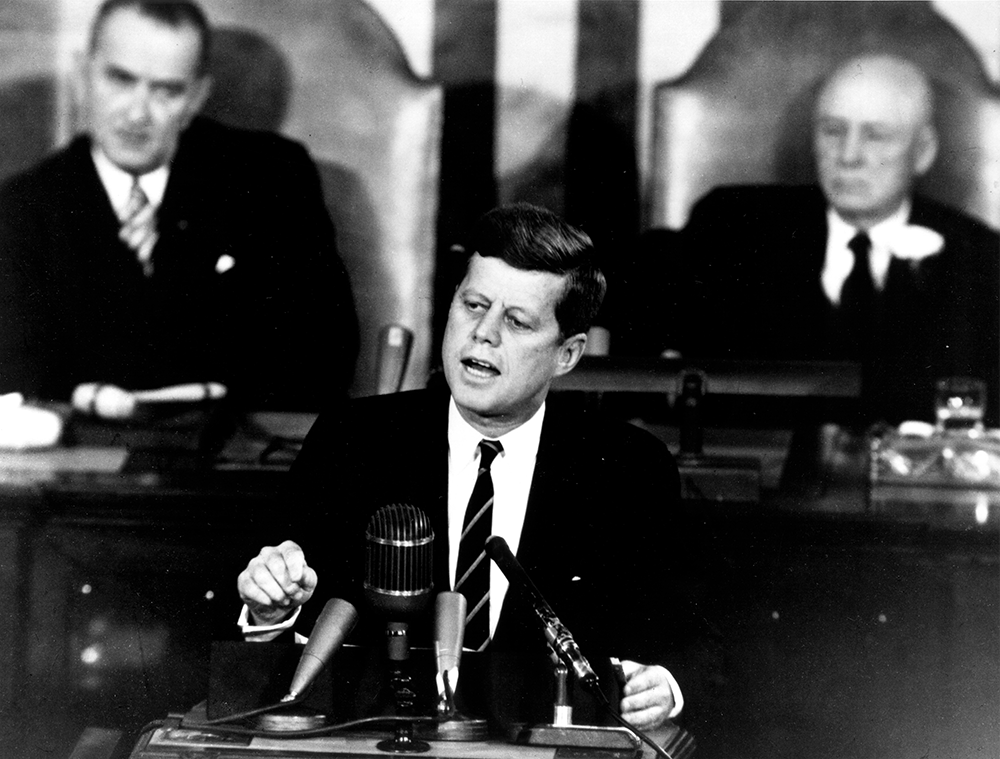
JFK speaking to congress about the “moonshot.” Bob Inglis says we need this kind of ambition—that put a man on the moon—to transform our energy system. (Photo: NASA)
CURWOOD: Congressman, what was the moment that you realized that you needed to take the climate on as an issue, come hell or high water in terms of your career and electability?
INGLIS: In three steps, really, with the third probably being the most conclusive, but first step was my son saying to me when he was voting for the first time in '04 and I was running again for Congress he said, "Dad, I'll vote for you, but you're going to clean up your act on the environment." His four sisters agreed, his mother agreed so I had a new constituency that was important to me to respond to. The second step was seeing the evidence in the ice core drillings in Antarctica in a science committee trip there. And the third step, the one that caused me finally to act was checking out coral bleaching at the Great Barrier Reef, snorkeling with an Aussie climate scientist and being able to tell that we shared a worldview in the way that he was interacting with nature. Before we had words about what that worldview was, I could tell that he was worshiping God in the Creation, he was not worshiping the Creation. And so afterwards, having plenty of time to talk, he told me about conservation changes he's making in his life in order to love God, and love people, and I found that real inspiring. I wanted to be like Scott, loving God, loving people. So I came home and introduced the Raise Wages Cut Carbon Act of 2009 which economists would call a revenue neutral border adjustable carbon tax, but what's better marketed as a 100 percent returnable emissions tax, I suppose. Neither description would help me in the greatest...in the darkest days of the Great Recession. So I lost my reelection in 2010.
CURWOOD: Speaking of God, the Pope is making an impassioned call for climate action and there are a lot of conservative and Catholic right to life voters who pay attention to the tenets of the church. How might that affect how those conservatives consider climate change now, do you think?
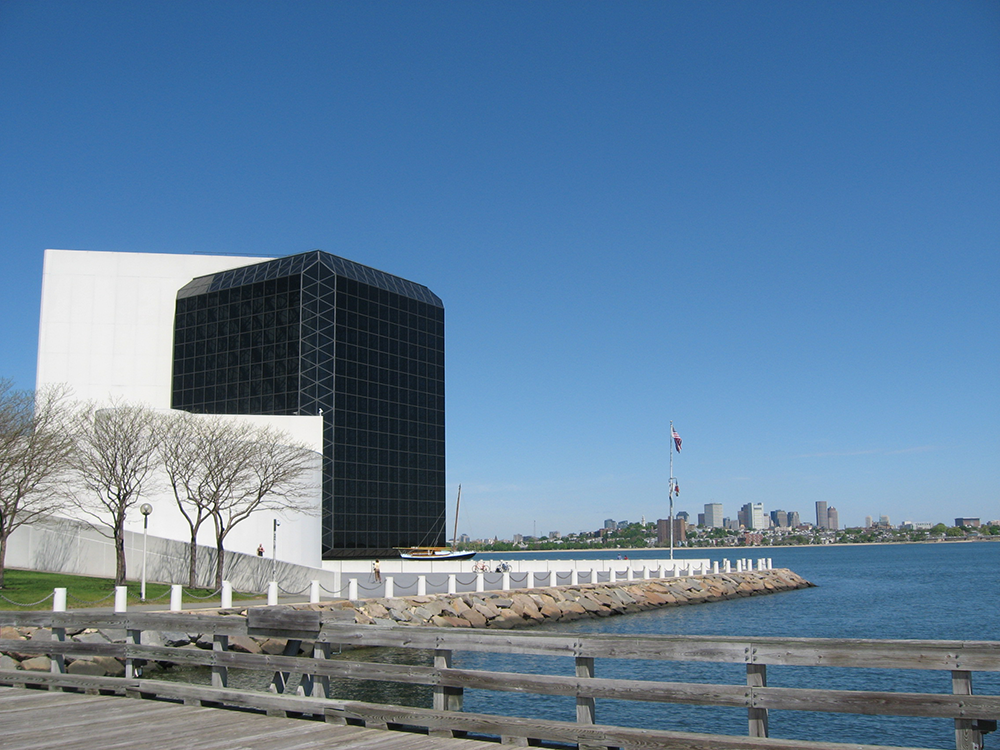
The JFK Library in Boston (Photo: Brian Herzog, Flickr CC BY 2.0)
INGLIS: Now I think it is a very important development that the Pope is going to issue this Encyclical. In many ways the Catholic Church led Evangelicals into the pro-life movement, and I think it may be the case that this Encyclical and the Pope's example may lead other believers into action on climate. So I'm very encouraged by it and think if it's anything like the statement by the pontifical science authority it'll be beautiful, it'll be really poetic, it'll be very inspiring, and it'll be quite a call to action so I think it's a big development that the Pope will an issue that Encyclical and I think also the speech at the joint session of Congress in September will be a very important moment. Because you know, there are many devout members of Congress who have for a long time derided “cafeteria Catholics”, those aren't willing to accept the church’s teaching on abortion. So now do they become cafeteria Catholics if they refused to accept the church's teaching on climate change?
CURWOOD: Very interesting question, huh? What's next for you?
INGLIS: The next thing is to build this group of conservatives who believe in the power of free enterprise, and that way we're doing is in an outfit called RepublicEN.org and so it's basically trying to give a tribal identity to conservatives who believe in the power of free enterprise to solve really big challenges like climate change, and so we are gathering people to that identity of creating a community because the most powerful thing is just showing that we're not alone. We as humans need to have connections with other people and so we're going to show that there are conservatives out here ready to act on climate change.
CURWOOD: Former South Carolina Congressman Bob Inglis is a recipient of this year's JFK Library foundation profiles in courage award. Thank you so much Congressman for taking the time.
INGLIS: Great to be with you, Steve. Thank you.
Related links:
- Read more about the JFK Library Profiles in Courage Award
- Bob Inglis runs Republicen.org
[MUSIC - BIRDNOTE® THEME]
BirdNote: Vocabularies of Birdsong
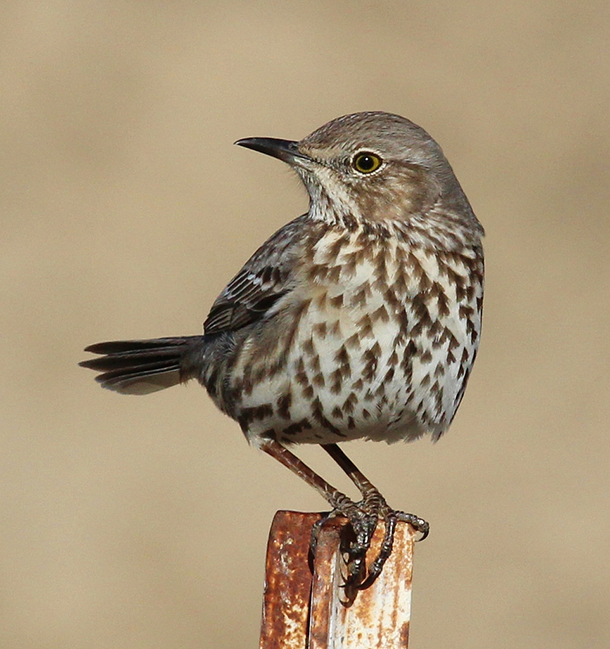
Sage Thrasher (Photo: © Tom Benson)
CURWOOD: One of the great pleasures of spring is the birdsong that’s suddenly all around us from before dawn till way beyond dusk. And the tunes these songsters create are as varied as they are, as Mary McCann explains in today’s BirdNote®.
BirdNote®
Voices & Vocabularies: Songs Long and Short
MCCANN: Bird songs come in many shapes and sizes. When a Sage Thrasher, perched atop a clump of sagebrush, tips its head back to sing, the notes rush forth.
[Sage Thrasher song]
What you just heard is a mere snippet. Sage Thrashers often sing non-stop for at least two minutes, and can go on for more than twenty. In stark comparison, a Brewer’s Blackbird, singing to the world from atop a fence post, sounds brusque.
[Brewer’s Blackbird song]
One full song from a Brewer’s Blackbird lasts barely a second.
[Brewer’s Blackbird song]

Brewer’s Blackbird (Photo: © Ken Schneider)
Amazingly, a Henslow’s Sparrow values brevity even more.
[Henslow’s Sparrow song]
That was it. In case you missed it…here it is again.
[Henslow’s Sparrow song]
But whether long-drawn-out or short-and-sweet, bird songs are all about the same things: territory and breeding. Claiming a space and attracting a mate. Once those are sorted out, further singing by the male is all about keeping his territory intact.
[Sage Thrasher song]
As for the Sage Thrasher? He’s still going strong...
[Sage Thrasher song]
I’m Mary McCann.
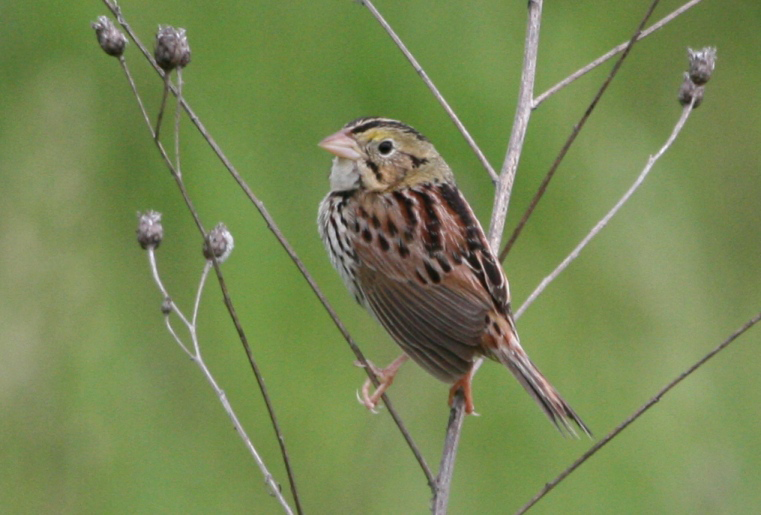
Henslow’s Sparrow (Photo: © Nancy Magnusson)
###
Written by Bob Sundstrom
Bird sounds provided by The Macaulay Library of Natural Sounds at the Cornell Lab of Ornithology, Ithaca, New York. Sage Thrasher 175693 recorded by G F Budney; Brewer's Blackbird [188802] recorded by Bob McGuire; Henslow's Sparrow [188892] recorded by Randolph S Little.
BirdNote’s theme music was composed and played by Nancy Rumbel and John Kessler.
Producer: John Kessler
Executive Producer: Dominic Black
© 2015 Tune In to Nature.org May 2015 Narrator: Mary McCann
Brewer’s Blackbird - Kenneth Cole Schneider https://www.flickr.com/photos/zonotrichia/5548989126
Henslow’s Sparrow - Nancy Magnusson https://www.flickr.com/photos/34312269@N04/7345570276
Sage Thrasher - Tom Benson https://www.flickr.com/photos/40928097@N07/12739808474
http://birdnote.org/show/voices-and-vocabularies-songs-long-and-short
CURWOOD: You can find pictures and more at our website, LOE dot org
Related link:
Learn more about these birdsongs and their species on BirdNote
[MUSIC: Xavier rudd, Follow the Sun, Spirit Bird, Salt X Records, 2012]
CURWOOD: Next time on Living on Earth, the wolves of Isle Royale in Lake Superior are in terrible shape.
PETERSON: Well, given the genetic make-up of the current three that are left, I wouldn't give it a chance at all of survival. Without new genetic material, I'd say it's a doomed population.
CURWOOD: And that’s not just bad for the wolves, it’s also bad news for science. That’s next time on Living on Earth from PRI.
[VOICES OF THE SWAMP track 8]
We leave you this week deep in a southern swamp.
[PIG FROGS GRUNTING, AND OTHER SWAMP NOISES]
Pig frogs make the loudest grunts in this pond in the Okefenokee National Wildlife Refuge in Georgia.
But you can distinguish the treble notes of Cricket frogs, and the distinctive “ca-tuck, ca-tuck” calls of Carpenter Frogs.
[PIG FROGS, CRICKET FROGS AND OCCASIONAL CARPENTER FROGS]
Lang Elliott and Ted Mack recorded this frog concert for the Nature Sound Adventure Series, Voices of the Swamp.
CURWOOD: Living on Earth is produced by the World Media Foundation. Our crew includes Naomi Arenberg, Bobby Bascomb, Emmett Fitzgerald, Lauren Hinkel, Helen Palmer, Adelaide Chen, Jenni Doering, John Duff, James Curwood, and Jennifer Marquis. Our show was engineered by Tom Tiger, with help from Jake Rego Noel Flatt and John Jessoe.
Alison Lirish Dean composed our themes. You can find us anytime at LOE.org - and like us, please, on our Facebook page - it’s PRI’s Living on Earth. And we tweet, but not in poetry, from @LivingOnEarth. I'm Steve Curwood. Thanks for listening.
ANNOUNCER1: Funding for Living On Earth comes from the Grantham Foundation for the protection of the environment, supporting strategic communication and collaboration in solving the world’s most pressing environmental problems. The Kendeda Fund, furthering the values that contribute to a healthy planet, and Gilman Ordway for coverage of conservation and environmental change. Living on Earth is also supported by Stonyfield Farm, makers of organic yogurt, smoothies and more, www.stonyfield.com.
ANNOUNCER2: PRI. Public Radio International.
Living on Earth wants to hear from you!
Living on Earth
62 Calef Highway, Suite 212
Lee, NH 03861
Telephone: 617-287-4121
E-mail: comments@loe.org
Newsletter [Click here]
Donate to Living on Earth!
Living on Earth is an independent media program and relies entirely on contributions from listeners and institutions supporting public service. Please donate now to preserve an independent environmental voice.
NewsletterLiving on Earth offers a weekly delivery of the show's rundown to your mailbox. Sign up for our newsletter today!
 Sailors For The Sea: Be the change you want to sea.
Sailors For The Sea: Be the change you want to sea.
 The Grantham Foundation for the Protection of the Environment: Committed to protecting and improving the health of the global environment.
The Grantham Foundation for the Protection of the Environment: Committed to protecting and improving the health of the global environment.
 Contribute to Living on Earth and receive, as our gift to you, an archival print of one of Mark Seth Lender's extraordinary wildlife photographs. Follow the link to see Mark's current collection of photographs.
Contribute to Living on Earth and receive, as our gift to you, an archival print of one of Mark Seth Lender's extraordinary wildlife photographs. Follow the link to see Mark's current collection of photographs.
 Buy a signed copy of Mark Seth Lender's book Smeagull the Seagull & support Living on Earth
Buy a signed copy of Mark Seth Lender's book Smeagull the Seagull & support Living on Earth

